The Langtang Valley Trek is a unique expedition in the Himalayas of Nepal. While shorter than many other popular treks in Nepal, the adventurous expeditions and day-hikes throughout this route make it one of my favorites. After three days of trekking, you will reach Kyanjin Gompa. From this small mountain town, there are several incredible day-hikes with fantastic views.
The short 3-day trek into Kyanjin Gompa makes this trek shorter, cheaper but arguably more beautiful than other treks such as Manaslu Circuit, Everest Base Camp Trek, or the Annapurna Circuit. I did this trek with the trekking company Himalayan Masters who I’ve trekked with
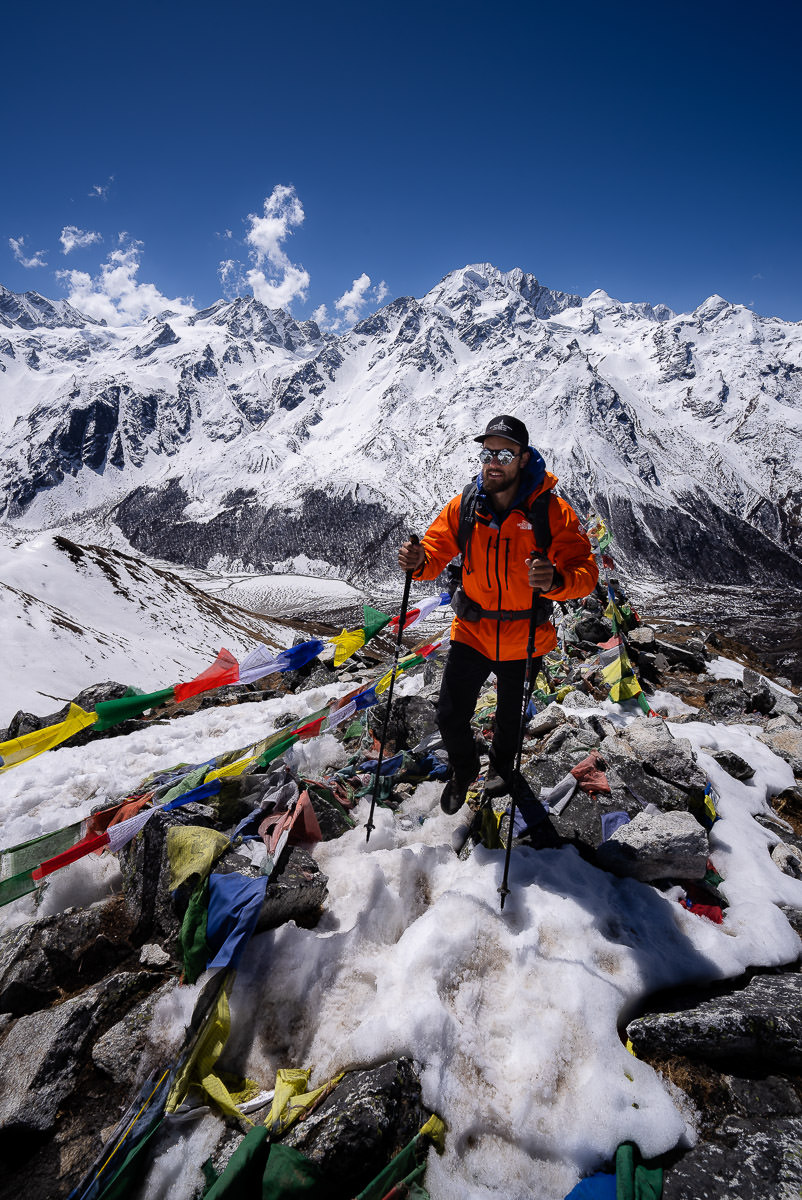

In this blog post, I will cover everything you need to know about the logistics of the Langtang Valley Trek. I’ll also share with you my experience on each day of the trek in the form of a short journal entry and my photos from that day. This will give you an idea of what to expect and a great insight into the scenery you will find on each day of the trek. I’ve already created a lengthy guide for the nearby viewpoints such as Tserko Ri, Kyanjin Ri, or the climb of Yala Peak.
Before sharing my experience in the second section of this blog post, I will detail all of the information you have to know in this complete guide about the Langtang Valley Trek and climbing Yala Peak.
BEST TREKKING COMPANY IN NEPAL
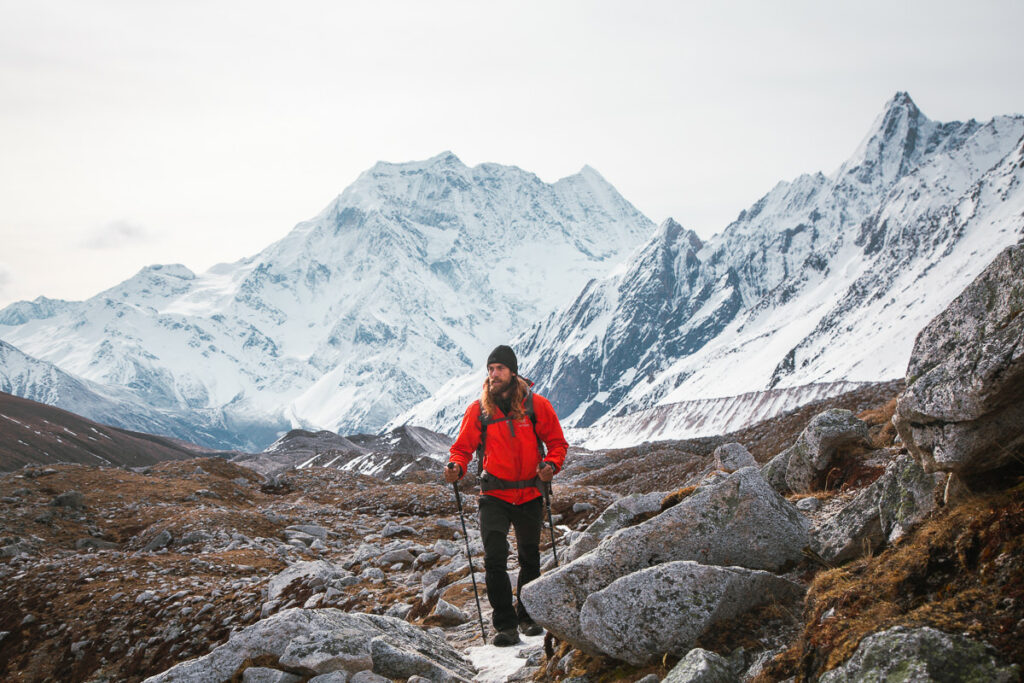
Interested in trekking in Nepal or doing the Everest Base Camp Trek?
I recommend booking your trek with Himalayan Masters, which is the company I use for all of my treks in Nepal. Use my code JACKSON5 when you book to receive a 5% DISCOUNT.
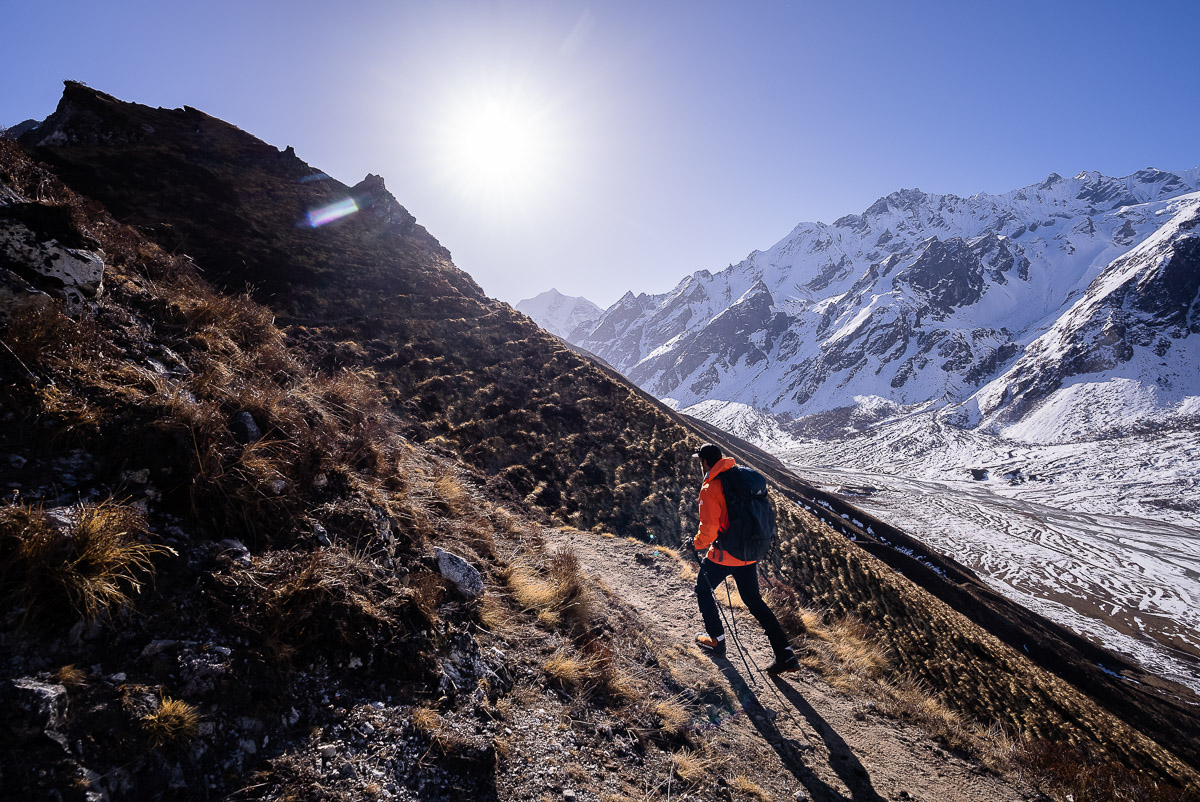

A GUIDE TO THE LANGTANG VALLEY TREK
In this guide, you will find all of the valuable information you need to plan your trek as well as my personal experience on the entire trek including the Kyanjin Ri Viewpoint, Tserko Ri Viewpoint, and Yala Peak climb.
LANGTANG VALLEY TREK DETAILS
- Distance: 77km or 48 miles
- Days required: 9 days including 2 days of transit to and from Kathmandu (7 days trekking)
- Total Incline: 4000 meters
- Total Decline: 4000 meters
- The highest point on the trek: From Kyanjin Gompa you can reach Kyanjin Ri (4,773m) or Tserko Ri viewpoint (5,033m). Additionally, you can climb Yala Peak from Kyanjin Gompa, which has an altitude of 5,500m.
- Difficulty: The Langtang Valley Trek is much shorter than Everest Base Camp or the Annapurna Circuit although relativley similair. You will reach an altitude of 5000m, which will challenge many. Altitude sickness can be common. The route ascends quite quickly with several days having more than 1000m of altitude gain. These days of ascent are tiring and also require the body to adjust quickly. It is a good beginner trek in Nepal but not one to be taken lightly.
- Permits: You will need a TIMS card and Park Entrance Permit, both can be purchased when entering the park.
- Guide: A guide is not required on this trek. However, the guide manages all of the logistics, distances, directions, and tea houses for your group. I used maps.me to navigate from tea-house to tea-house and found the paths easy to follow. If it’s your first time trekking in Nepal, I would suggest having a guide.
- Accommodation: Guest Houses, also known as Tea Houses, are available along the way where you will sleep in a comfortable bed and have access to showers (extra charge) and restaurant facilities. It was very comfortable accommodation and great after a long day of hiking. Most of the villages were Tibetan, which gave us a great insight into their unique culture.
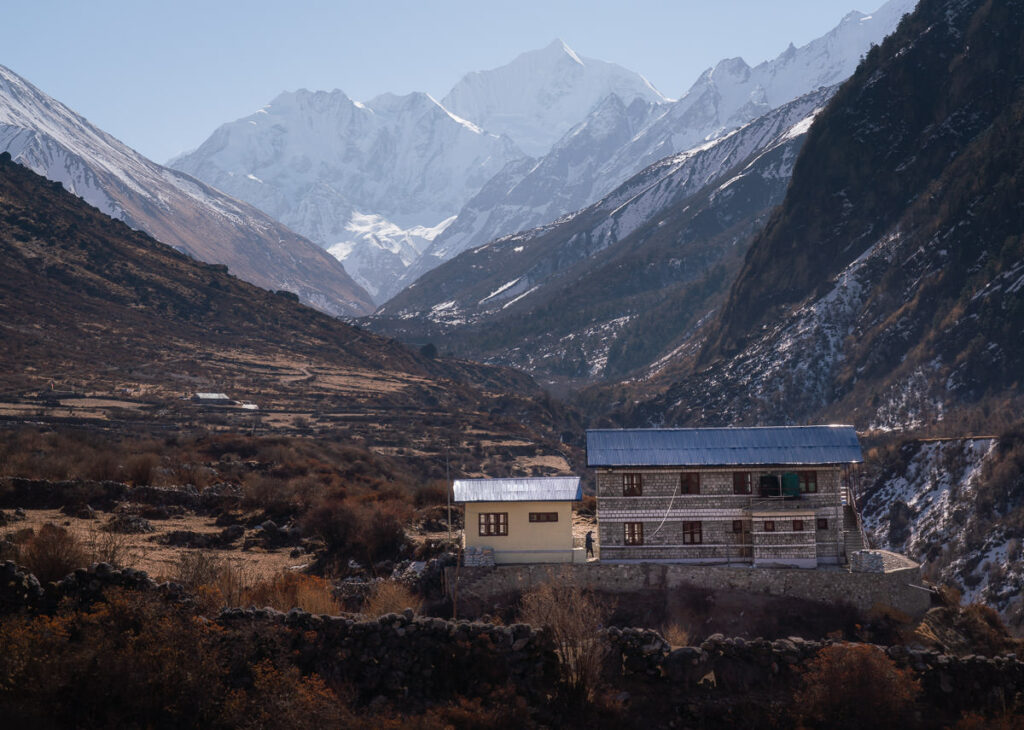

TRY THE 3 BEST TREKS IN NEPAL

Manaslu Circuit: My personal favorite 2-week trek through Tibetan villages and stunning scenery. Less crowded and more authentic.
Annapurna Circuit: The most beautiful & scenic 2-week trek in Nepal although can be crowded at times.
Everest Base Camp Trek: The most iconic 2-week route reaching the famous (EBC) Everest Base Camp at 5,300m.
KEY POINTS ABOUT THE LANGTANG VALLEY TREK
- This circuit is way less crowded than Everest Base Camp Trek or the Annapurna Circuit. It is growing in popularity but it’s still a great time to trek this circuit before it hits the mainstream.
- There are teahouses in each village along the way so each night you get a great sleep in a bed with blankets, have access to showers, eat great meals in a restaurant, and can charge your electronics and cameras.
- The trailhead can be reached by car so there is no need to pay for expensive domestic flights.
- I think it is important to base in Kyanjin Gompa for atleast three nights so you can hike up to Kyanjin Ri and Tserko Ri, which are the highlight of the trip.
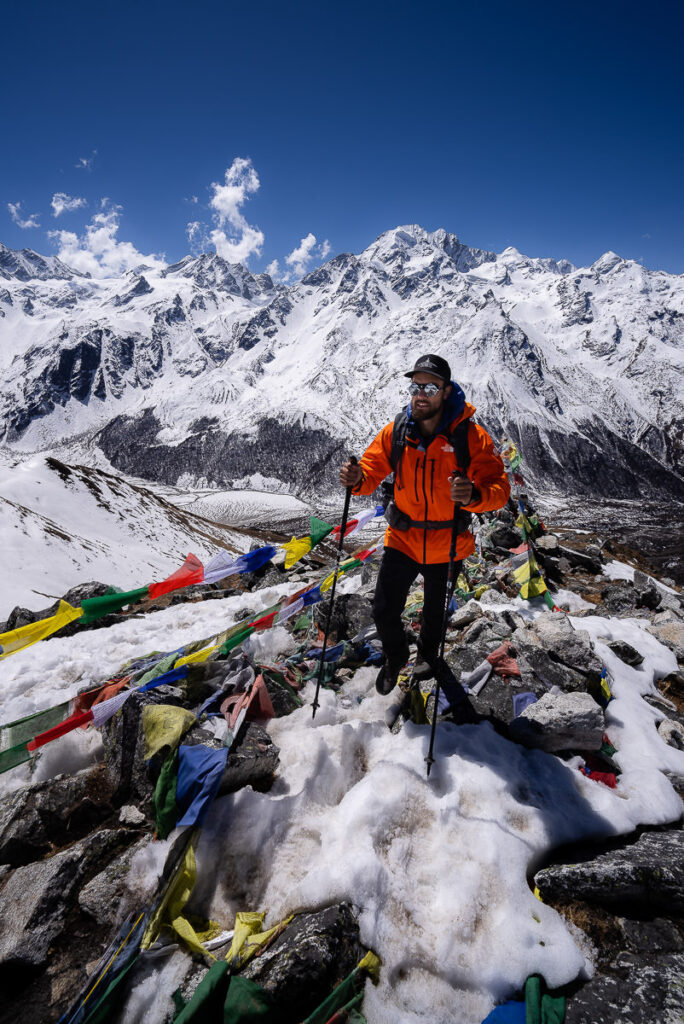
BOOKING A GUIDE FOR THE LANGTANG VALLEY TREK
The Langtang Valley Trek doesn’t require a guide but it’s great to have a guide managing the logistics such as directions, tea-houses, distances, medical issues, and the overall organization. I’d say 80% of trekkers go with a guide. I did the trek with Himalayan Masters which is one of the top trekking companies when it comes to the Langtang Valley Trek.
The trek costs around $800 USD with Himalayan Masters as of 2022 and includes all transfers, accommodation, meals, drinks, permits, and even the hotel stay before and after the trek at a high-quality hotel. I honestly had a great time on this trek and I can wholeheartedly recommend Himalayan Masters.
You can use my discount code ‘JACKSON5‘ for 5% off the total price of your trek with Himalayan Masters which is a pretty handy saving.
Email: [email protected]
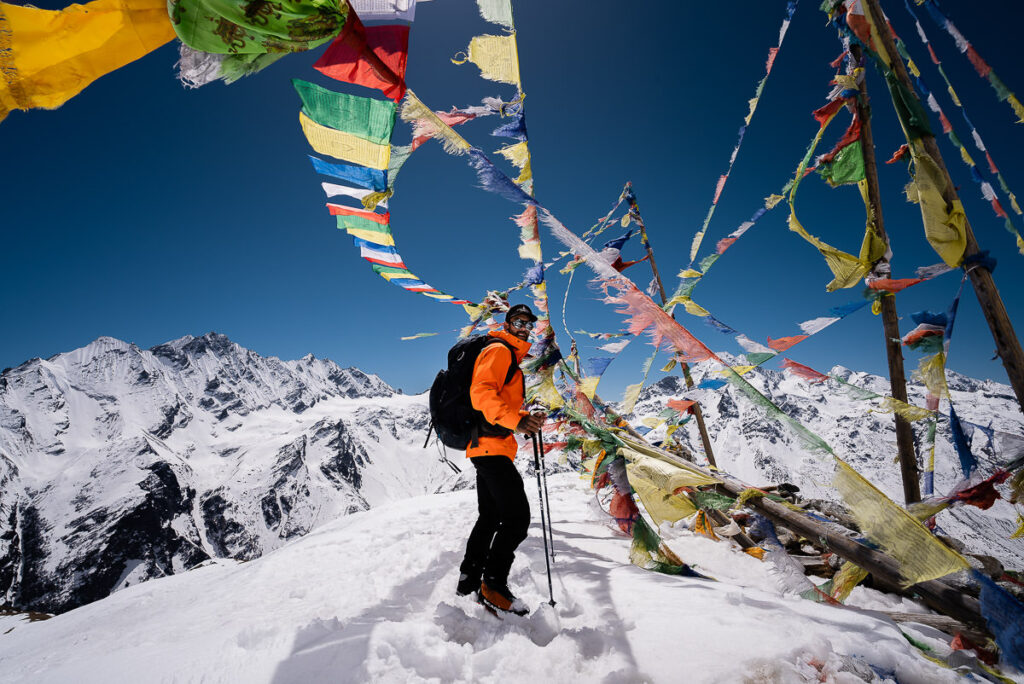
LANGTANG VALLEY TREK PACKING LIST
I packed pretty light and managed to wash most of my clothes each afternoon/night for the first half of the trip. In the latter stages of the trip, it was pretty cold so we weren’t sweating as much and we wore our warm gear basically nonstop while at the teahouses. There was no real need for multiple outfits.
This is just a guide and it worked quite well for me with no complaints from my set-up. You won’t need a sleeping bag as there are blankets in each guesthouse and when it got cold I just wore my down jacket to bed. This meant I didn’t have to carry a sleeping bag for the entire trek.
- 1 pair of pants that maybe convert to shorts
- 1 pair of shorts
- 1 Warm or thicker pair of hiking pants
- 1 Long sleeve quick-dry shirt
- 1 Long-sleeve thermal shirt
- 2 Short-sleeve t-shirts
- 1 Thermal long underwear
- 4 pairs of quick-dry underwear
- 1 Lightweight down jacket
- 1 Heavy-duty summit down jacket
- 1 Beanie
- 1 Cap
- Sunglasses
- 1 Neck Buff
- Gloves
- Hiking boots
- Headtorch
- 1 pair of warm summit socks
- 2-3 pairs of regular socks
- Sunscreen
- Trekking poles
- Water filter
- Powerbank
All of this should fit into a backpack no bigger than 50L and should be less than 14kg.
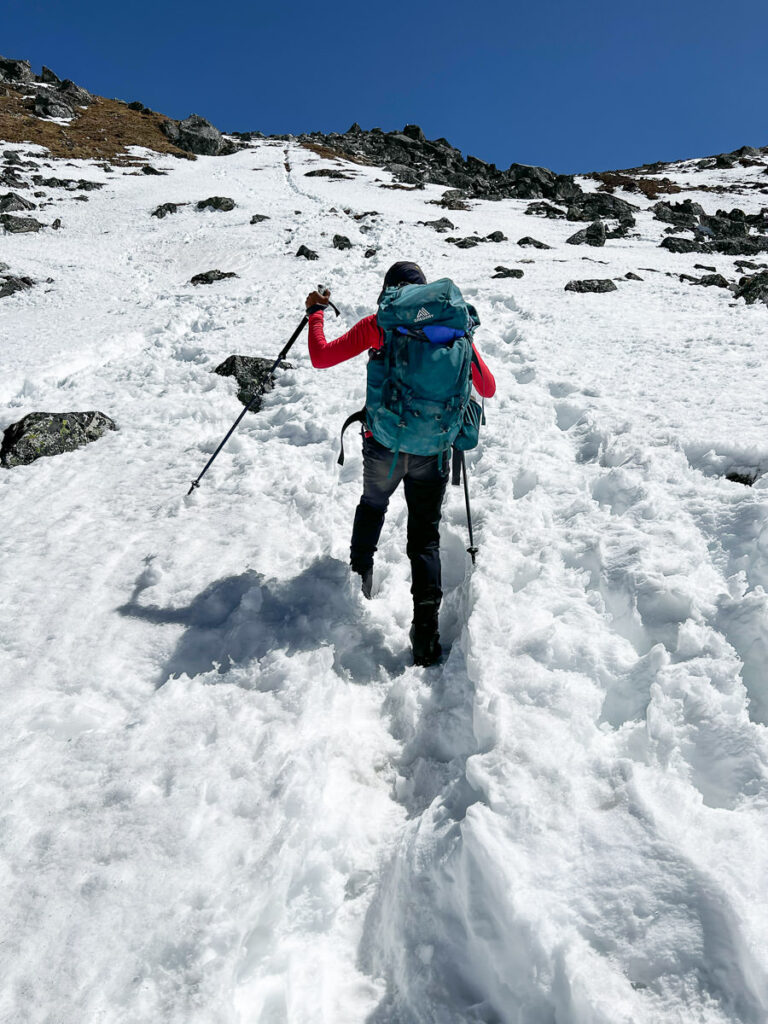
WIFI/ELECTRICITY AVAILABILITY ON THE LANGTANG VALLEY TREK
- Wifi: Costs anywhere from $free to $4 to use wifi at the guesthouses. Buy an NTC Sim before you go. It worked in most spots after Lama Hotel with a weak signal but we were able to send emails, watch Youtube, and message friends from Langtang and Kyanjin Gompa.
- Electricity: You will have to pay anywhere from $free at low elevation to $5 to charge your power banks, cameras, and phones. The key is to get a big power bank. Pay to charge it then charge everything from your power bank. My power bank lets me charge my phone and four camera batteries before it dies. Most of the places we stayed let us charge our gear for free but when it is busy they usually charge a fee as many teahouses run off gas or solar.
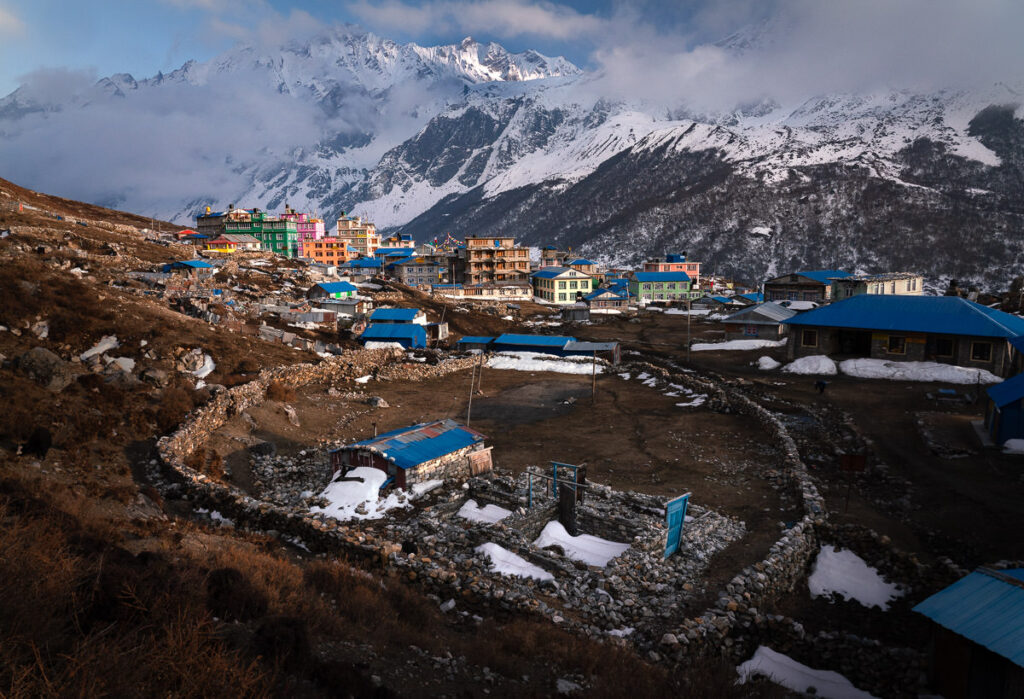
TOP 3 PLACES TO STAY IN KATHMANDU

- Ultimate Luxury: The Dwarika’s Hotel – Luxury, Spa-service, Pool
- Best Value: Aloft Kathmandu Thamel – Swimming Pool, Gym & Great Restuarant
- Budget Choice: Hotel Jampa is easily the top cheap hotel in Kathmandu
LANGTANG VALLEY TREK ITINERARY
This is one of the shorter treks in Nepal and has a straightforward itinerary.
- Day 1: Drive from Kathmandu to Syabrubesi (1550m) 7 hours
- Day 2: Syabrubesi to Lama Hotel (2,380m) 6 hours
- Day 3: Lama Hotel to Mundu via Langtang Village (3,430) 6 hours
- Day 4: Mundu to Kyanjin Gompa (3,870m) 3 hours
- Day 5: Kyanjin Gompa to Tserko Ri to Kyanjin Gompa (5000m) 7 hours
- Day 6: Kyanjin Gompa to Lama Hotel (2,380m) 6 hours
- Day 7: Lama Hotel to Syabrubesi (1550m) 6 hours
- Day 8: Drive from Syabrubesi to Kathmandu 7 hours
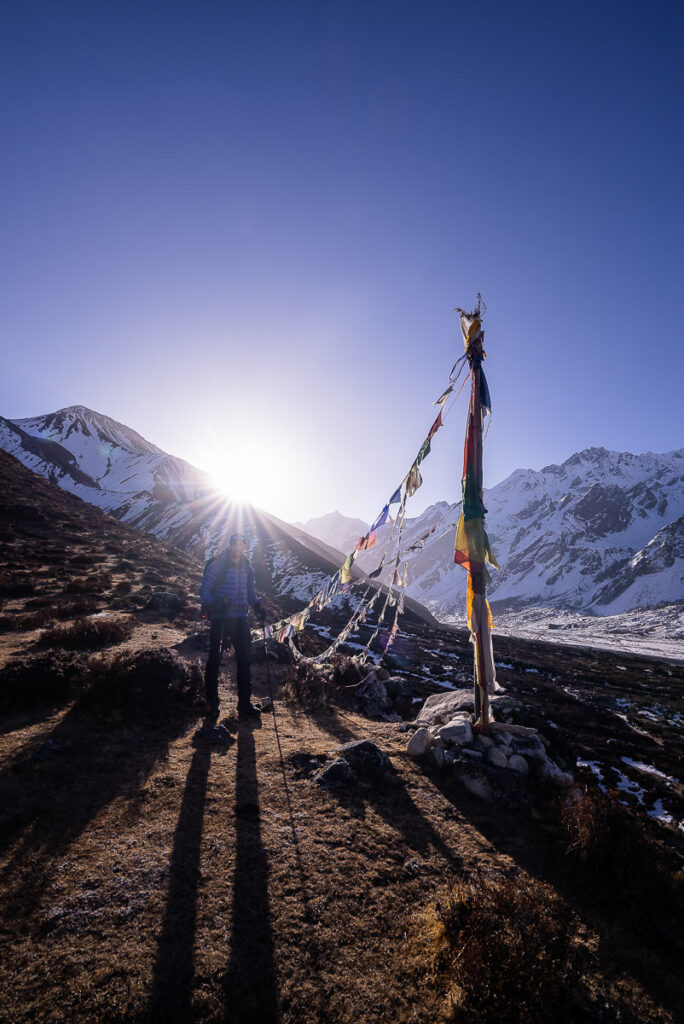
THE FULL VLOG FROM OUR LANGTANG VALLEY TREK
DRINKING WATER ON THE LANGTANG VALLEY TREK
I use the Grayl Ultralight Water Purifier and it is a game-changer for hiking in Nepal, making this super easy and cheap. The Grayl Ultralight Water Purifier removes 99.9999% of viruses of disease-causing bacteria. The best thing about it is it only takes 15 seconds and one press to purify water from any fresh water source. You don’t need to buy bottled water at every tea-house contributing to large amounts of plastic waste and costing you $4+ per day.
Along the Langtang Valley Trek, we filled up at tea-houses, rivers, and local village taps. Unlike aqua purification tablets which require you to wait 30 minutes before drinking, you can have rehydrated yourself immediately with the Grayl Ultralight Water Purifier.
GrayL Water Purifier
- Never pay for water on the trek
- Save 3-4 plastic water bottles a day
- Turns any water into drinking water
INSURANCE FOR THE LANGTANG VALLEY TREK
Nepal can be a dangerous place for trekking or hiking because the high altitude can lead to many illnesses, weakness in trekkers, and misjudgments. There is also a risk on trails for falls, avalanches, or other mishaps. Your regular travel insurance probably won’t cover you at high altitude and won’t cover a helicopter evacuation. There is a solution though.
Need extra protection?
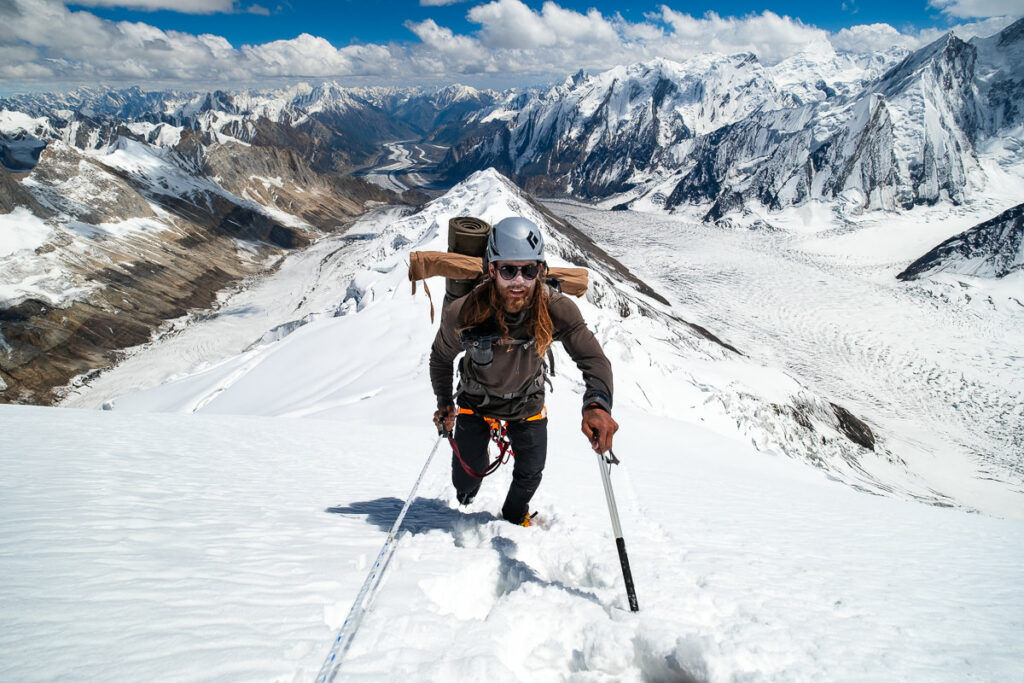
Regular travel insurance is great but won’t cover you for high altitude hikes or for helicopter evacuation. Each year, I purchase a Global Rescue Subscription.
For less than $500 per year or $100 per expedition, you can purchase a Global Rescue subscription and be covered no matter how extreme the hike or how high the climb is.
BEST TIME AND SEASON FOR THE LANGTANG VALLEY TREK
The peak season for the Langtang Valley Trek is March to April and October to November. The time to avoid this trek is during the rainy season from June to August.
During the winter from December to February, this region gets very cold and there will be snow cover in the higher parts of the trek. Many of the guesthouses actually close up for the winter and re-open in late February to March. However, it is possible to hike the Langtang Valley Trek on the fringe of the season in late February/early March and it can be quite beautiful with snow cover.
I hiked the Langtang Valley Trek in early March and it was warm during the day and got pretty cold at night. We experienced some heavy snow on Tserko Ri and Yala Peak but the trekking routes were clear.
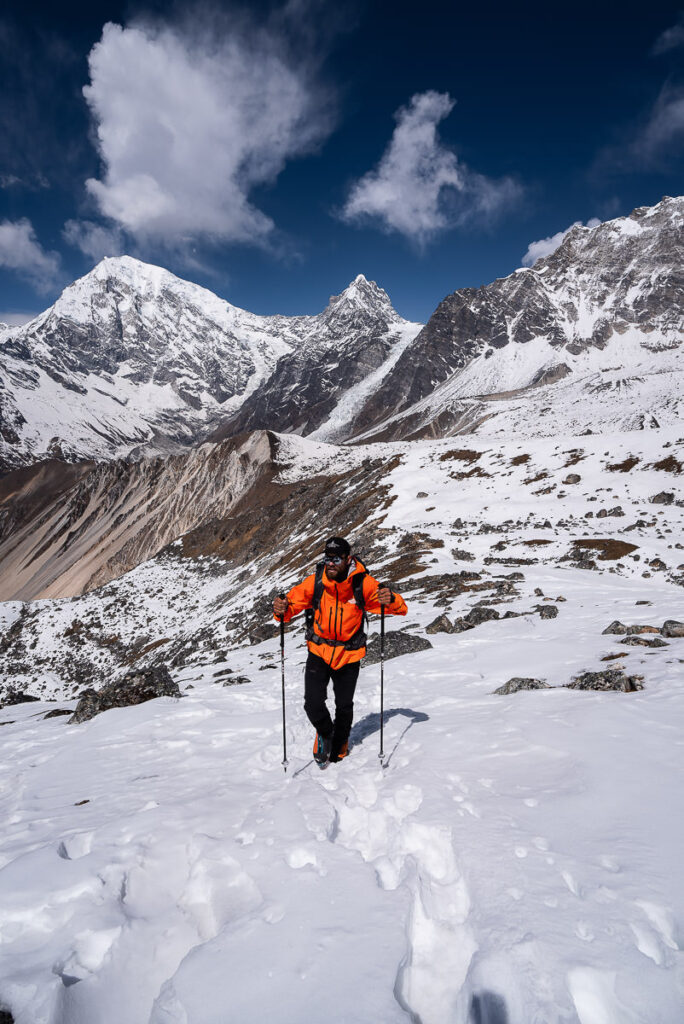
HOW TO GET TO THE LANGTANG VALLEY TREK
There are two main ways to reach Syabrubesi, which is the small town at the starting point of the trek. Despite the distance from Kathmandu to Syabrubesi only being 125km, the journey takes a long time due to the traffic and quality of the road.
Jeep: We went by private Jeep organized by our tour company Himalayan Masters. It costs about $180 to hire the vehicle out for the drive so can be split between your group. It’s not cheap but much less brutal than the lengthy bus journey.
Public Bus: The bus costs about $10 USD and can take anywhere from 7-10 hours depending on the traffic and if there are any roadworks or landslides recently. The bus leaves every day from Kathmandu to Syabrubesi at 6 am and 8 am as well as other defined times. The bus station in Kathmandu is called ‘New Bus Station’.
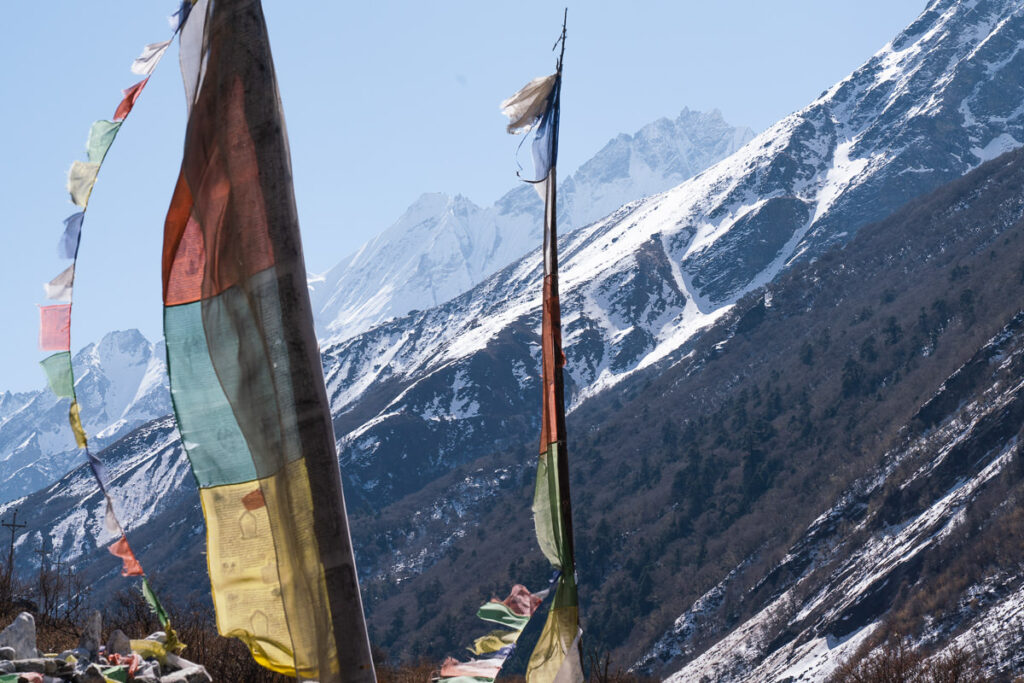
MY EXPERIENCE ON THE LANGTANG VALLEY TREK
Throughout this section of this guide, I will share my experience with each part of this trek. I found the Langtang Valley Trek quite unique as the trek in was actually not too exciting. However, it became an incredible experience once we reached Kyanjin Gompa and did the two hikes Tserko Ri and Kyanjin Ri as well as the Yala Peak climb.
So, unlike other treks where the trekking along the route is the highlight, I found that the time when we were based at Kyanjin Gompa was the highlight and found the trek into Kyanjin Gompa relatively mild.
TREKKING FROM SYABRUBESI TO KYANJIN GOMPA
Syabrubesi seems somewhat of a trekking town even though it is connected by road to the greater civilization. The main street is lined with guesthouses and some of the menus display prices that would see you are already in a remote mountain village.
I would recommend Hotel Lhasa for good Momo and friendly Tibetan owners. This is the last place you will have a reliable internet connection, a moderately warm shower, and a chance to buy any last-minute essentials.
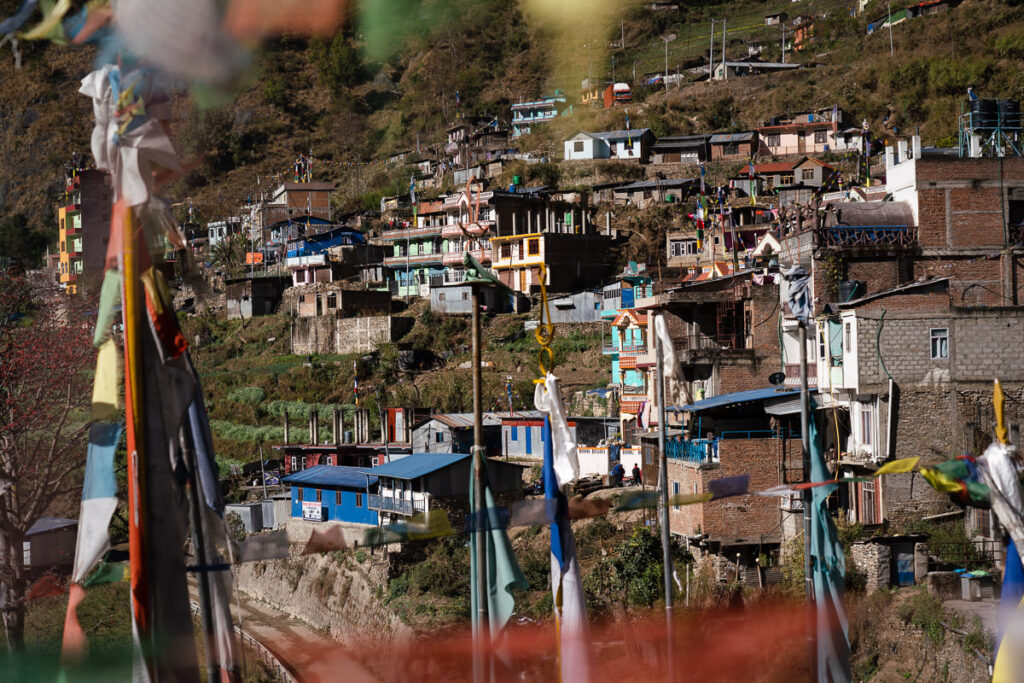
The journey from Syabrubesi to Kyanjin Gompa typically takes most trekkers three days. There are many different options for guesthouses along the way but most seem to follow a distinct route.
Lama Hotel (name of the town not the hotel) is the most common stop for the first night. The trek from Syabrubesi to Lama Hotel is quite intense and involves about 15 kilometers in distance. However, it is the 1200m of vertical gain and sun exposure that will knock you about.
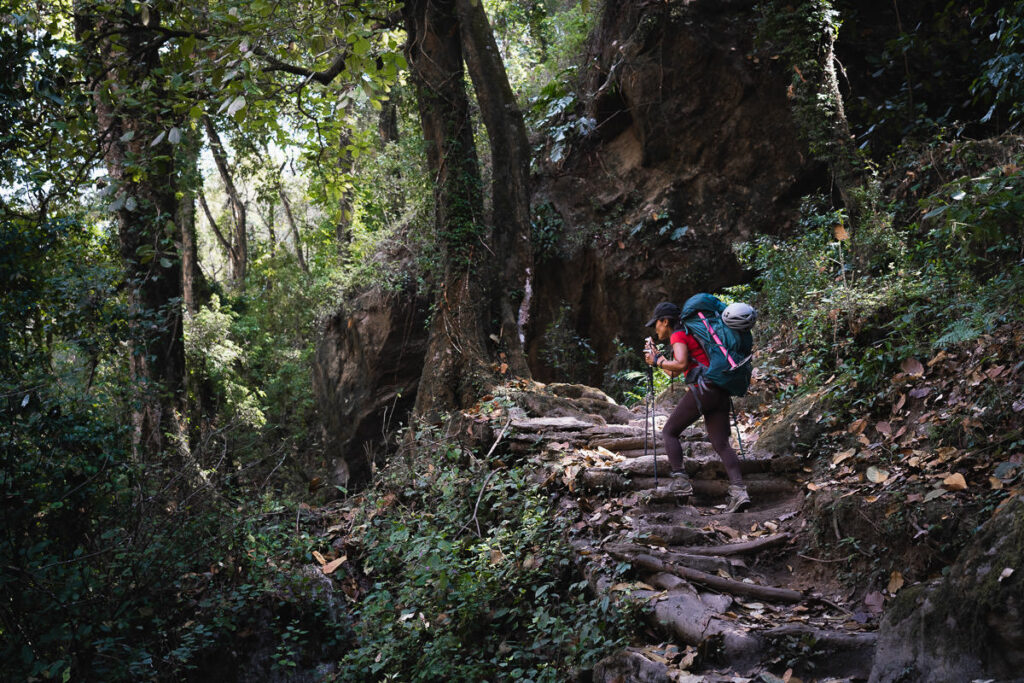
The trail begins alongside the river and has a lot of exposed sunny sections. The elevation isn’t high yet at just over 2300m so it can be very hot. Undulating alongside the river, the trail delves into the forest and careens up endless flights of rocky stairs. You can expect a few glimpses of snow-covered peaks but today is mostly about the river, forests, and a few bridge crossings as the highlights.
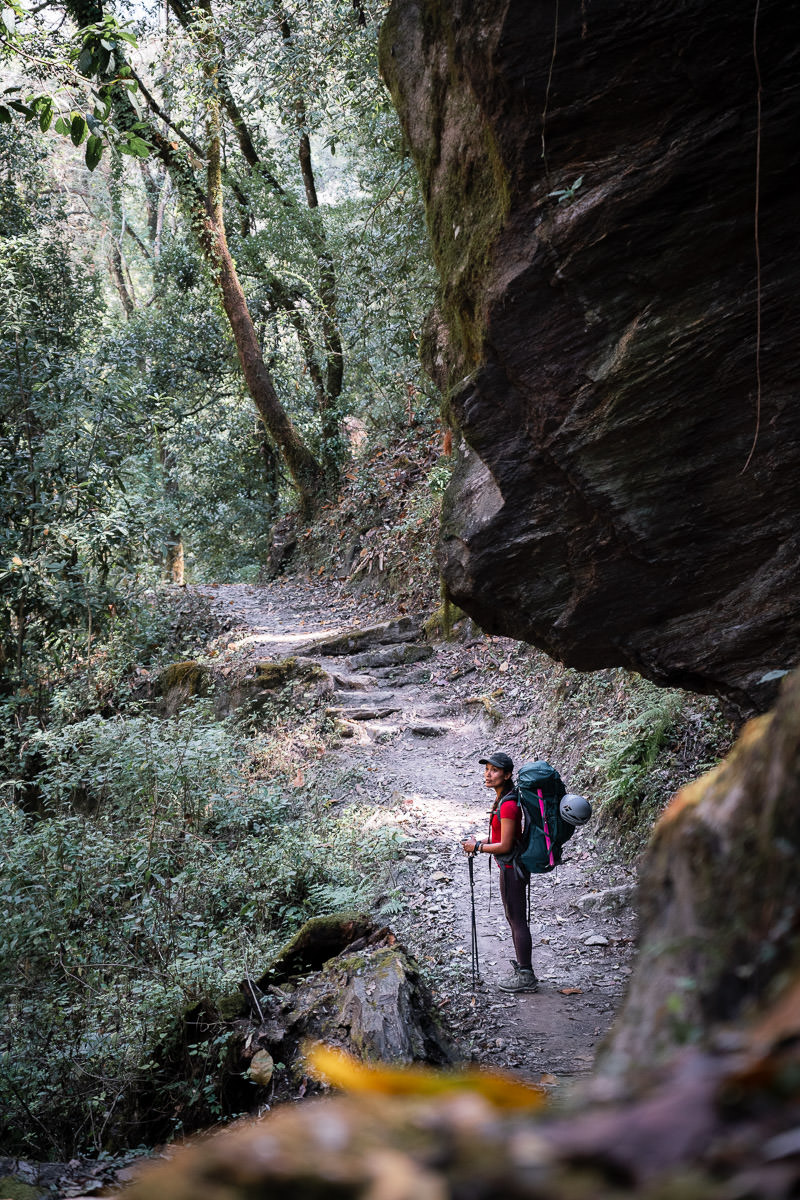
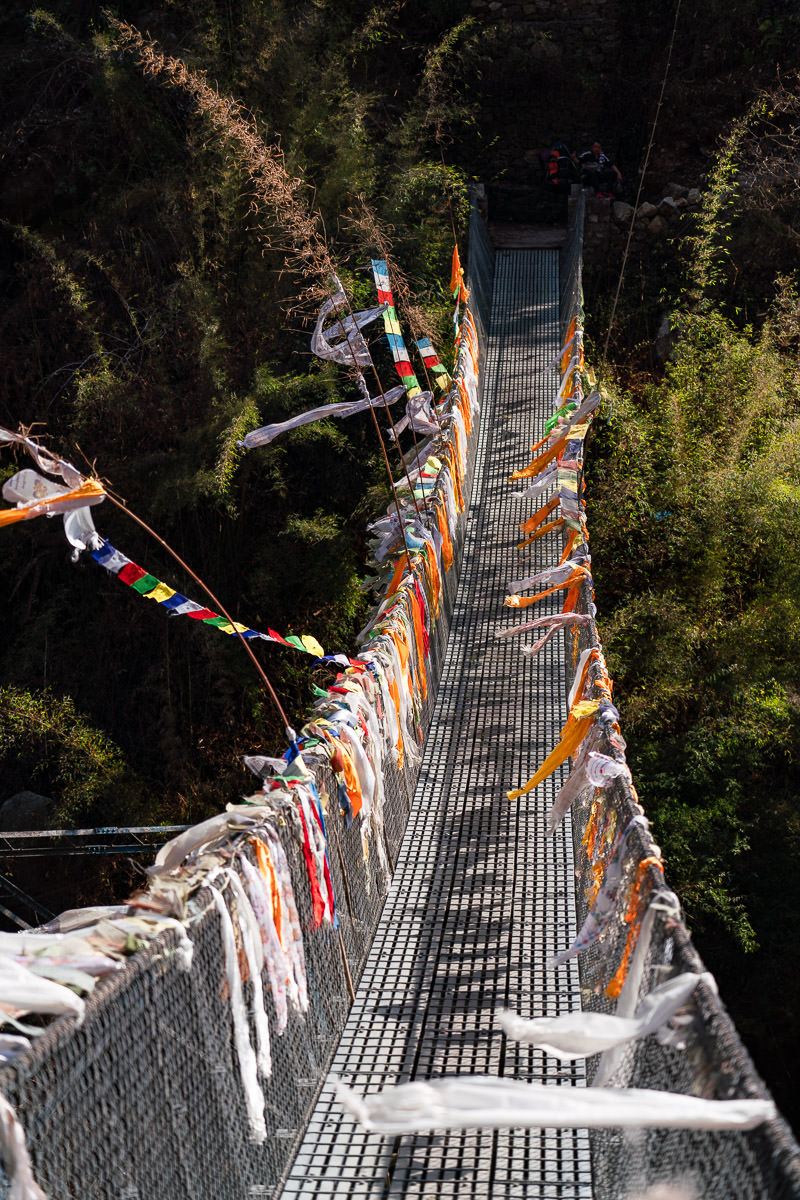
Upon reaching Lama Hotel, we were a little confused. There were six or seven hotels, all with Lama Hotel in their signage. Friendly Guest House Lama Hotel, Origin Lama Hotel, Sunrise Guest House Lama Hotel. It turns out this small village is just a collection of hotels and the location is known as Lama Hotel.
We ended up staying at the Friendly Guest House, run by a Tibetan family who was indeed friendly. Here we had a warm bucket shower, no signal, no electricity, great Tibetan food, a warm heater in the dining room, and comfortable beds with blankets. All you can ask for in the mountains really.
On our second day of trekking, we headed from Lama Hotel all the way to Langtang. You could stop earlier at smaller towns, but Langtang was recommended to us. The trail really opens up in the second half of the day as you break out of the forest and trek along the slopes of the valley towards Langtang.
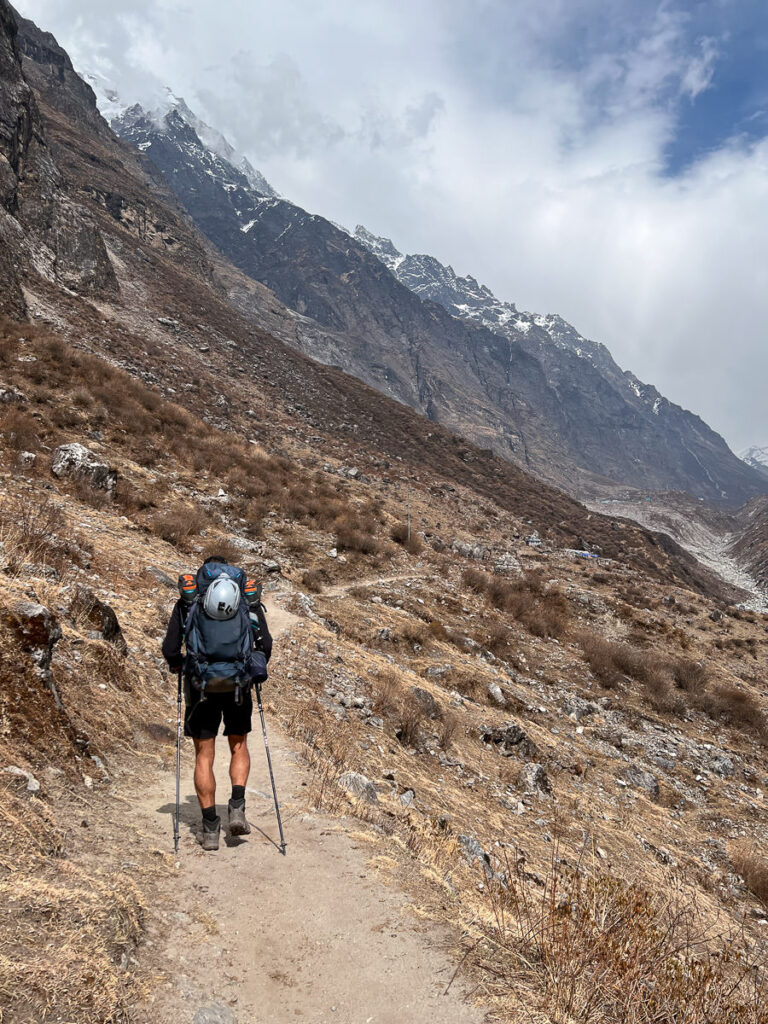
Snow-capped peaks begin to appear throughout the day. However, just after winter, the landscape is burnt orange. In the spring, you could expect lush green grass and wildflowers to create a much more vibrant setting. Personally, I prefer the trekking during the winter time when there are more snow-capped peaks.
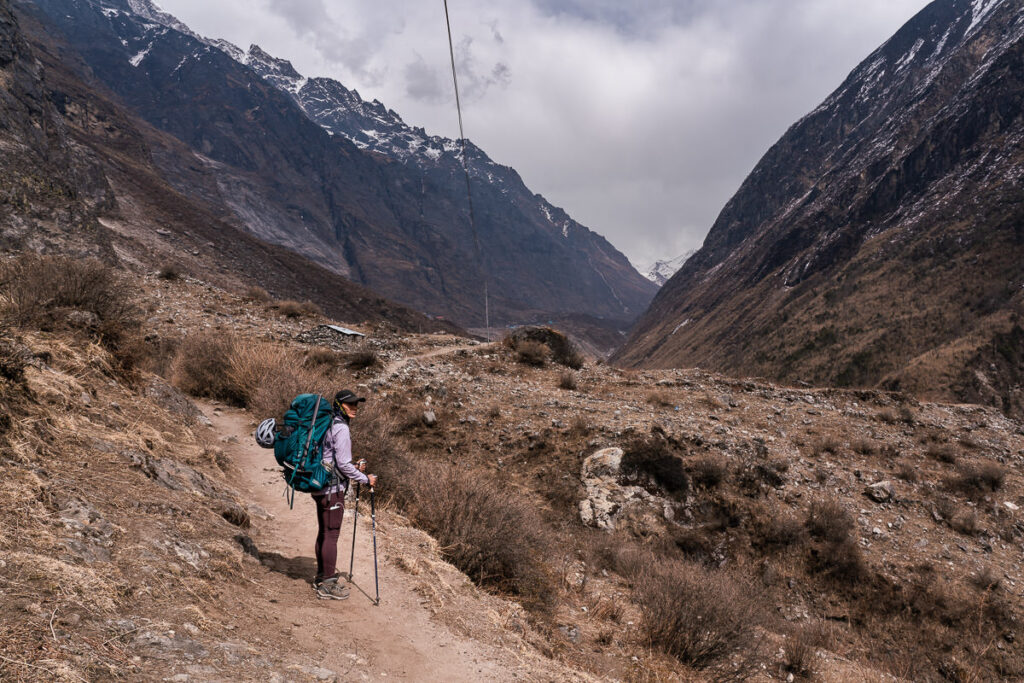


The journey from Lama Hotel to Langtang Village was about nine kilometers with almost 800 meters of incline. It was much softer than the first day but you are now reaching a higher elevation and may start to feel the oxygen thinning. In Langtang, I stayed at Chomo Valais and it had a hot shower and comfortable beds. It was similar to most tea-houses in the region and had a nice dining room with glass windows to enjoy the view.
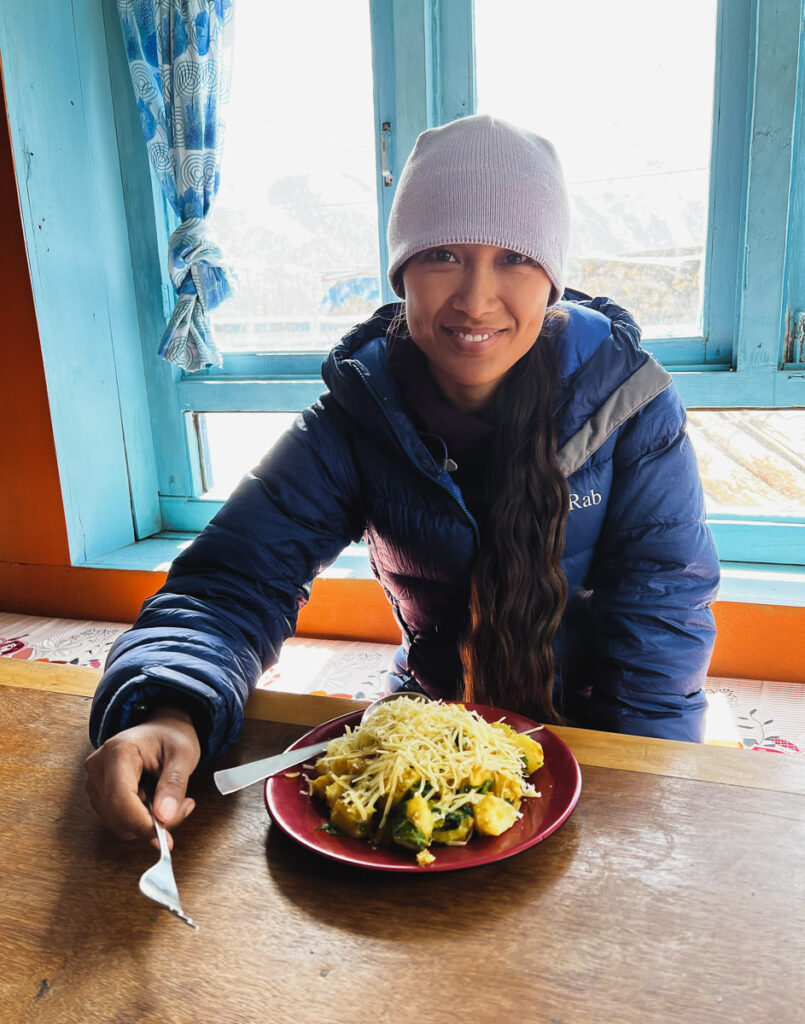
The final day of trekking from Langtang Village to Kyanjin Gompa is short and sweet. With just 6.5 kilometers and a few hundred meters of incline, it is by far the shortest day of the trek. Many people actually find it so short, they had up to Kyanjin Ri viewpoint on the same day as reaching Kyanjin Gompa.
On the way to Kyanjin Gompa, spectacular views of Tserko Ri and 7000m snow-capped peaks come into view. Following the river, you will pass by the stupa and monastery on your way into the town. Kyanjin Gompa is quite unique as the town is hidden from both sides until you basically reach the entrance due to the ridges and its hiding spot in the small valley.
I kept wondering when it would appear as the map said the entire town was just 150 yards away. I still couldn’t see any buildings, and then finally, we climbed the final hill and Kyanjin Gompa was revealed.
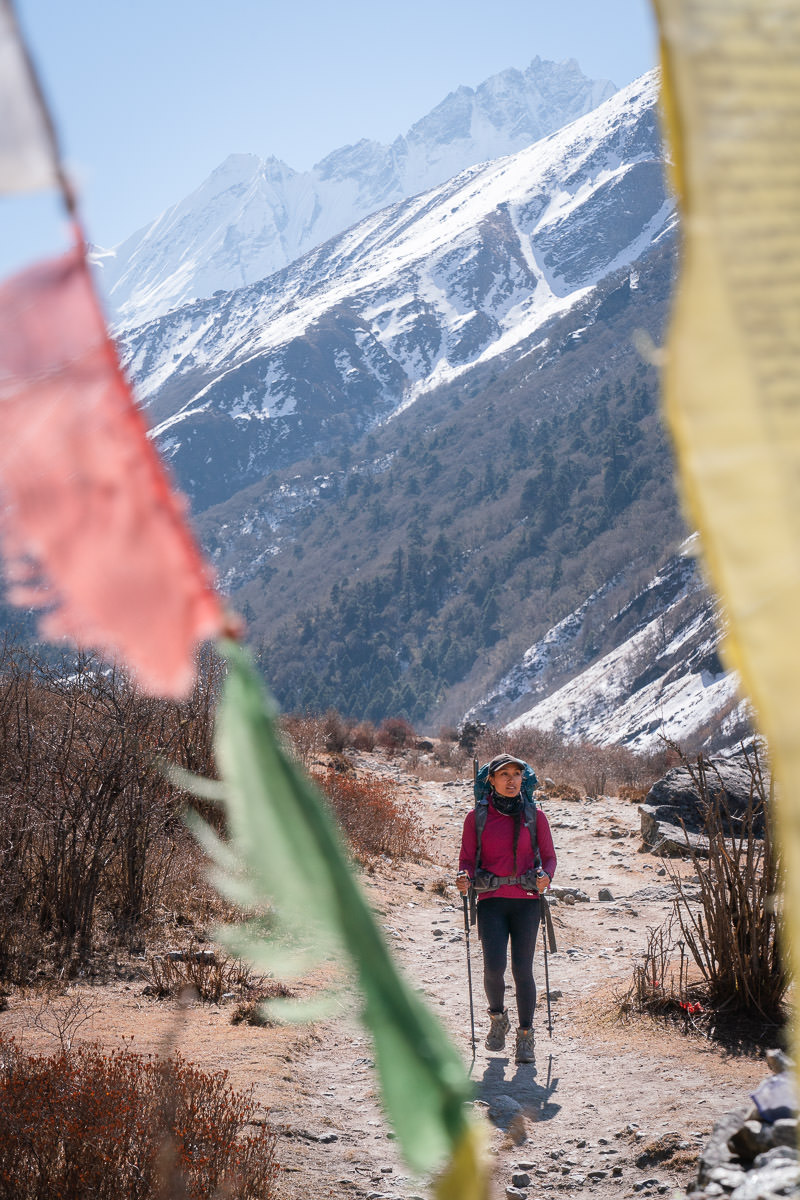
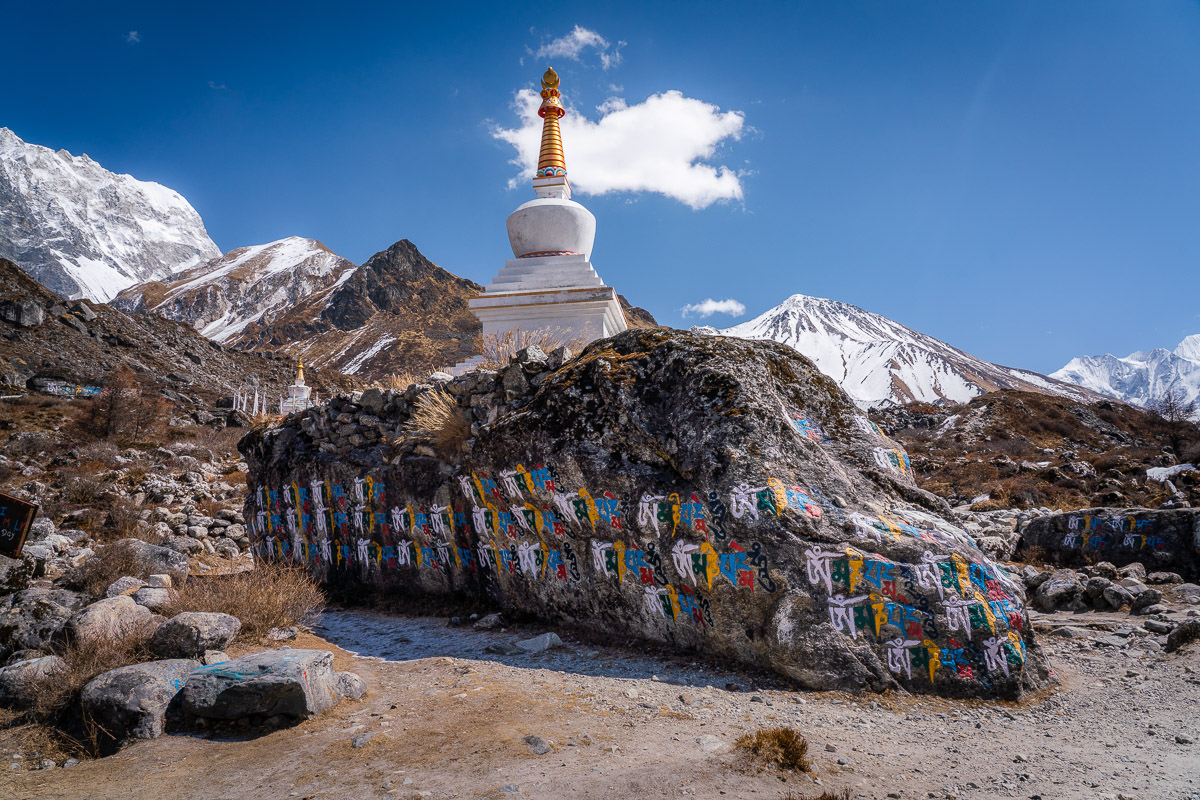
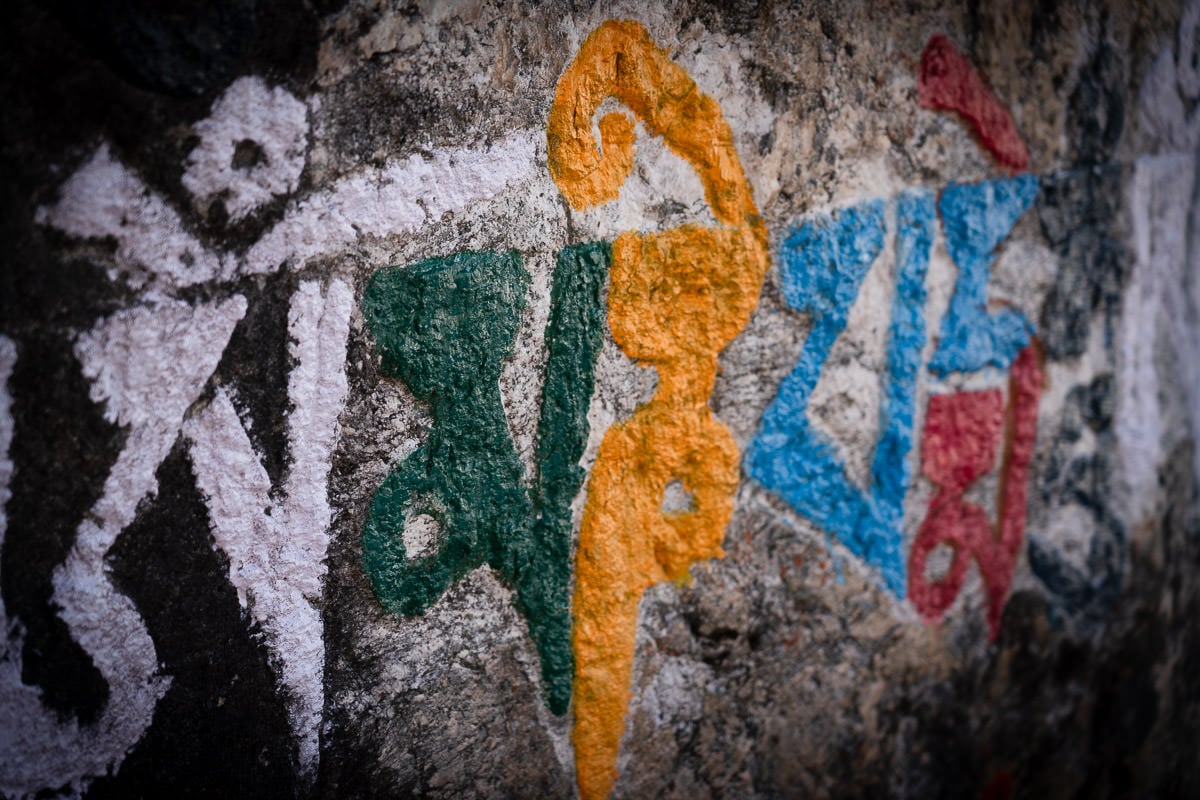
What are my favorite pieces of trekking gear?
There are six pieces of gear that I simply never forget when I go trekking. These are five items that I using right now and this list gets updated every year! Here are my trekking essentials.
- Arcteryx BETA AR Rain Jacket: This is my go-to rain jacket. It’s super light, folds down into a tiny ball, and protects brilliantly in a storm. This one never leaves my backpack.
- Salomon X Ultra 3 Mid GTX Hiking Boots: For the best ankle support, waterproofing, and durable exterior I’m a fan of tough but light hiking boots like these Salomons for my adventures.
- Black Diamond Head Torch: I can’t tell you how many times, I’ve arrived back from a hike unexpectedly late. I always keep this lightweight but strong headtorch in my bag for the unexpected.
- Darn Tough Socks: These are the most comfortable hiking socks I’ve ever worn and last for years. They also have a lifetime warranty and you just send them in with a hole and they replace it no questions asked.
- Osprey Atmos AG 65L Backpack: I’ve never had a more comfortable 65L pack than this one. I got it in the Navy Blue and have trekked with it through many a mountain.
- Black Diamond Trekking Poles: They might feel weird at first, but on a long trek with incline and decline you’ll begin to love these.
- Grayl GeoPress Water Filter Bottle: I’ve used this for three years. It filters your water with one press and you can drink directly from it. Never buy a plastic water bottle again!
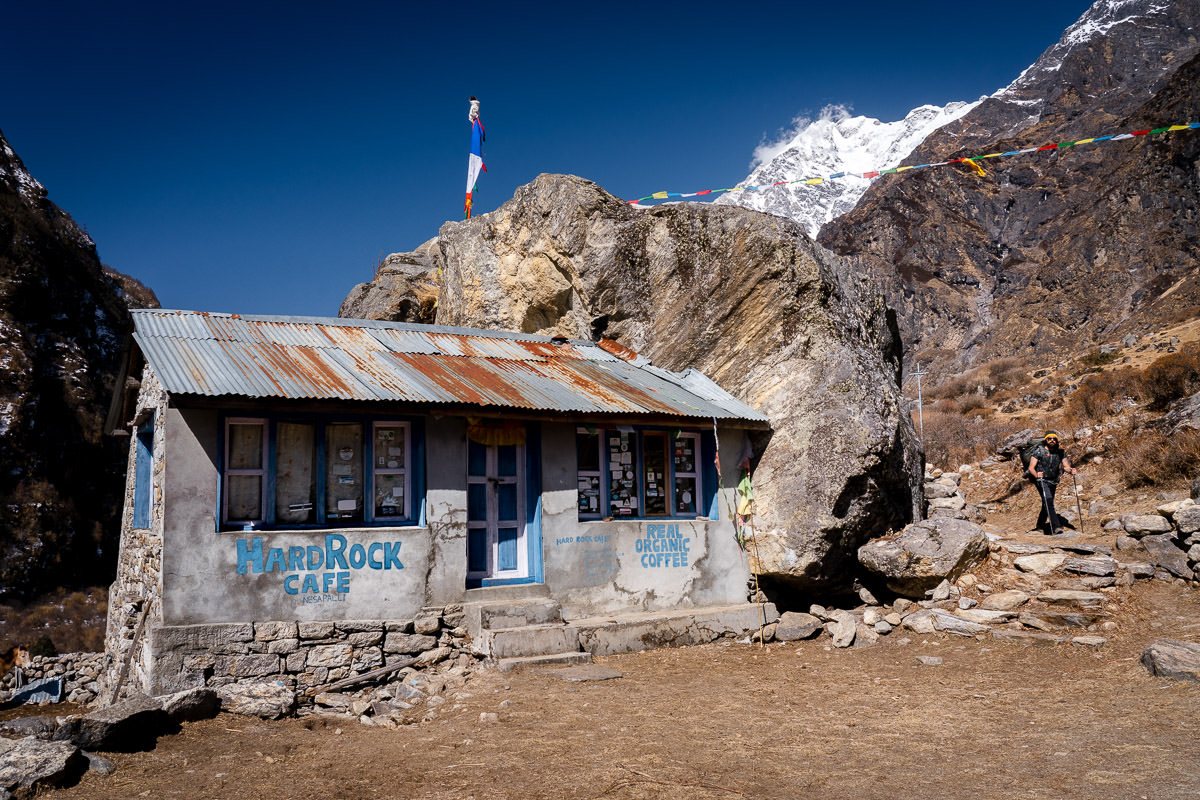



THINGS TO KNOW ABOUT KYANJIN GOMPA
Kyanjin Gompa is the end of the trek for most people. It’s a beautiful town with an incredible backdrop of snow peaks in all directions. The biggest mistake you can make on the Langtang Valley Trek is to stay one night and turn around and hike back down.
The absolute highlight of this trek is to base in Kyanjin Gompa for a few nights and spend one day hiking up Kyanjin Ri and one day hiking up Tserko Ri. We also spent another day climbing Yala Peak but that requires certain gear and experience.
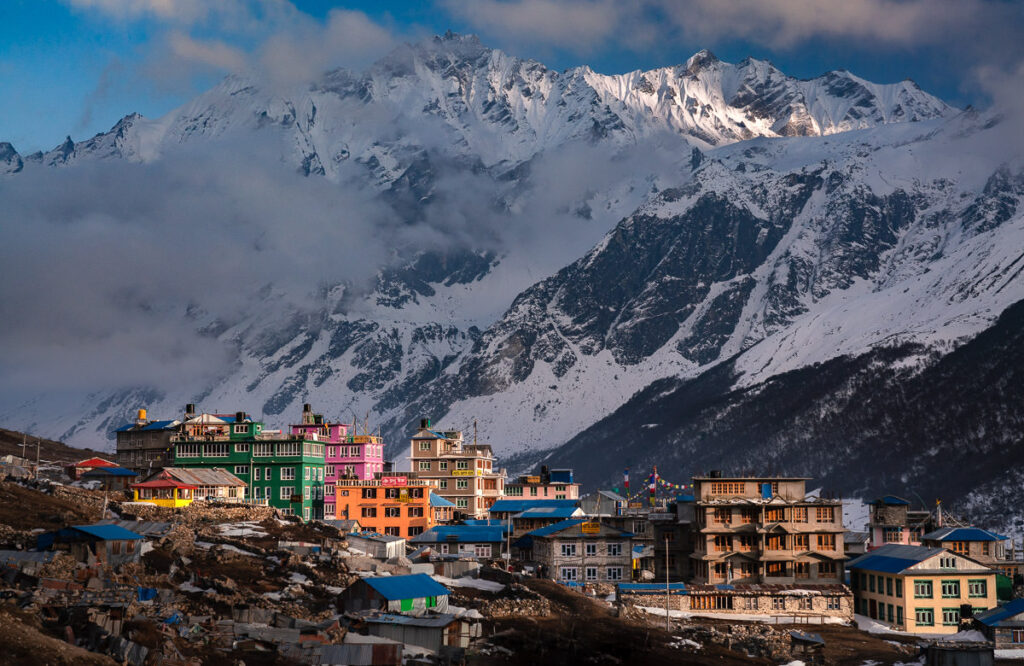
I ended up staying six nights in Kyanjin Gompa. My itinerary was the following:
- Kyanjin Ri
- Rest Day
- Tserko Ri
- Rest day
- Yala Peak Base Camp
- Yala Peak/Sleep at Kyanjin Gompa
Understandably that is a lot of time but we were also trying to acclimatize for Yala Peak so we added in the rest days. The trek in to Kyanjin Gompa was good but not amazing. I really found that the time spent in Kyanjin Gompa was what made this trek is so great not the actual trek in itself. This is different from many other treks such as Everest Base Camp or the Annapurna Circuit where each day of trekking is the highlight rather than a specific destination or a specific town.

I stayed at Mountain View Hotel while in Kyanjin Gompa. It’s one of the smaller, older guest houses and I really enjoyed it here. Unlike many of the new multi-story hotels in the village, this hotel just had two floors and a cozy dining room.
Mipsang, the owner, is one of the kindest and most caring guys we’ve met in Nepal. Say hello to him for us if you end up staying there.
At Mountain View Hotel we had had water showers, internet connection from our sim card, great food, comfortable beds and blankets, and electrical outlets available in the room.
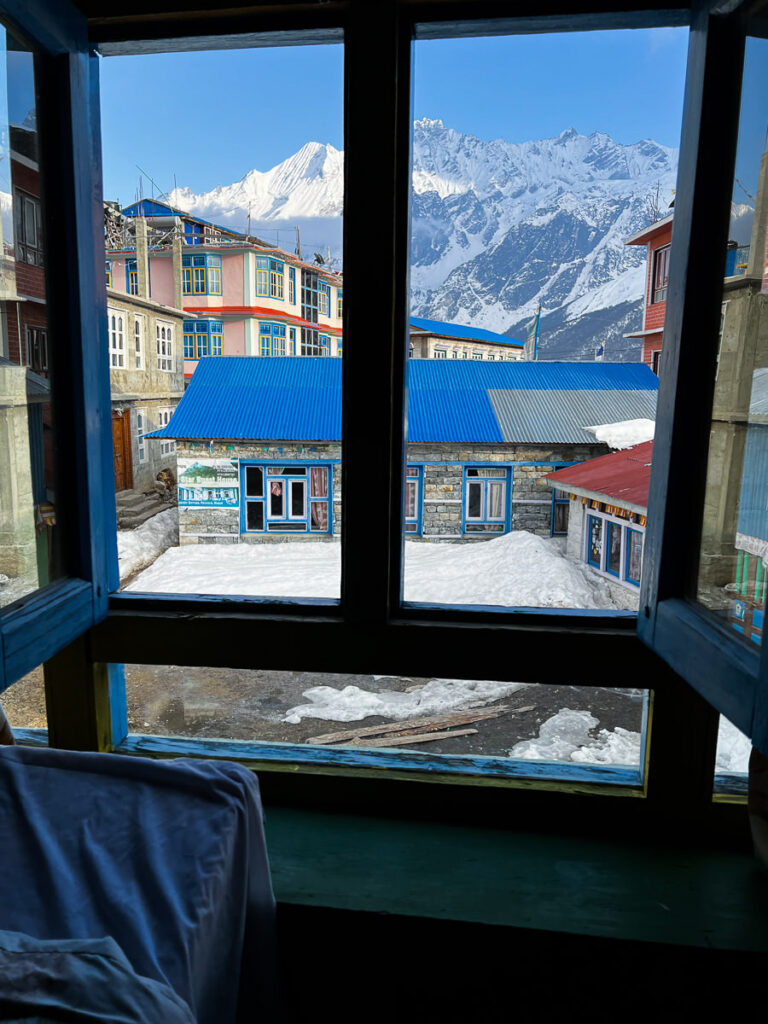
HIKING TO KYANJIN RI FROM KYANJIN GOMPA
From Kyanjin Gompa there are two awesome day-hikes. The smaller and most popular hike is Kyanjin Ri. This viewpoint towers over Kyanjin Gompa and has more than 700m of vertical gain in just a few kilometers. While short in distance, don’t underestimate this hike as it is incredibly steep and reaches heights of 4,700 meters.
The trail begins directly out of the town up the nearest ridge. A series of switchbacks leads you up to Lower Kyanjin Ri, which is the first viewpoint on the route. Covered in prayer flags, this viewpoint you will have you peering down over the entire town with jaw-dropping views across the valley.
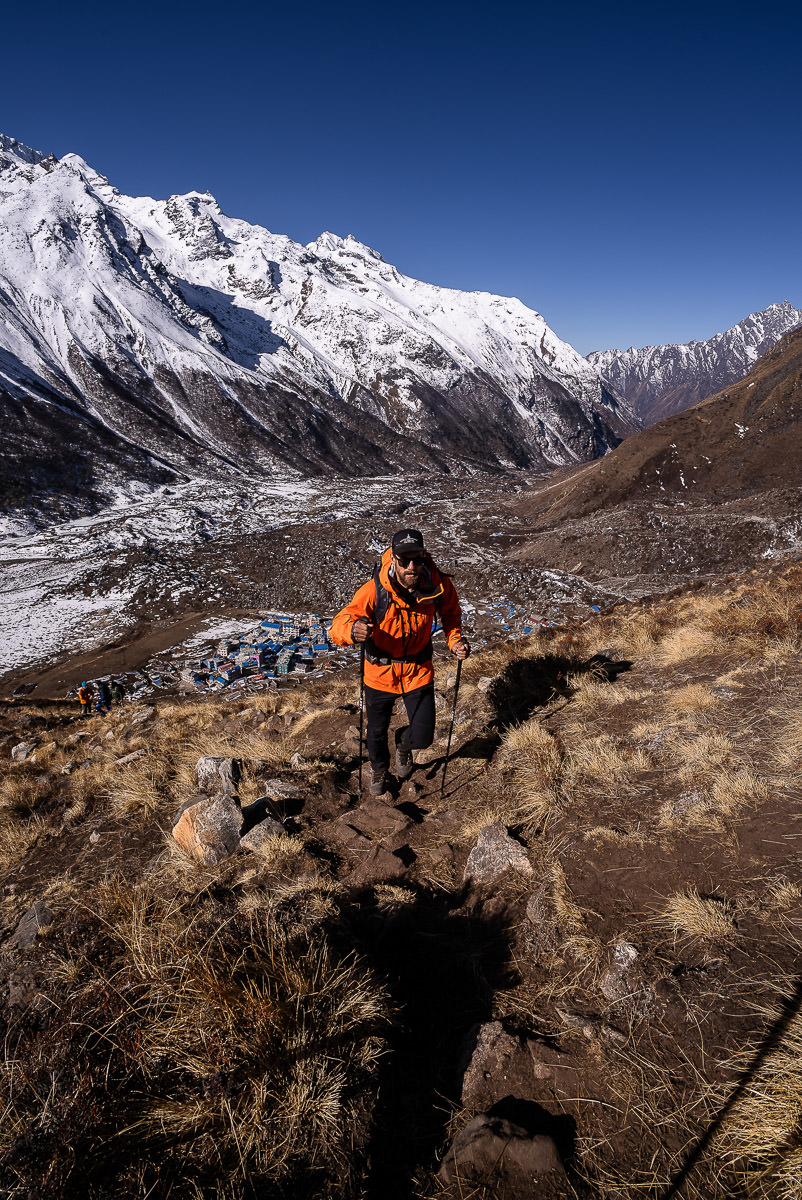
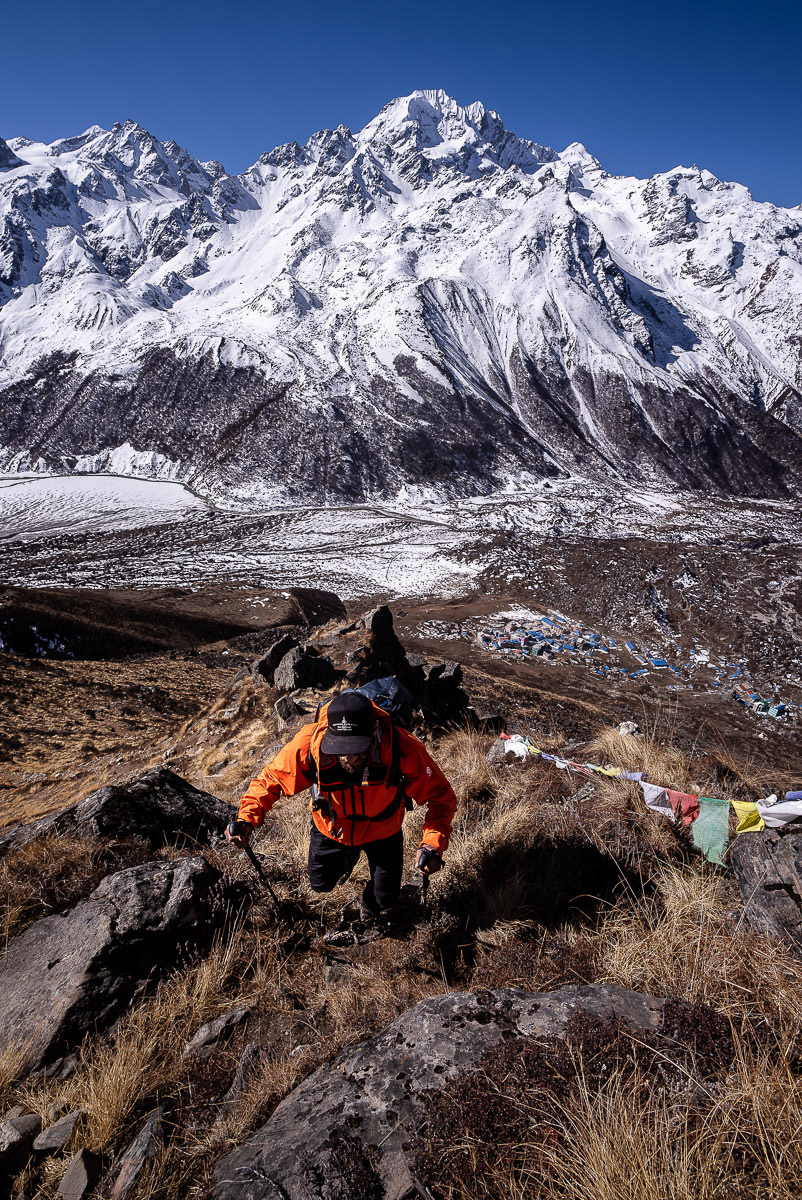
Continuing on, the ridge-line track continues higher and higher. We trekked just after winter and there was still considerable snow coverage for this trekking peak. Reaching Kyanjin Ri, we were walking across the snow at 4700m on a ridge overlooking the Langtang Lirung Glacier and the Langtang Lirung Peak (7,227m). To the right of Langtang Lirung you can find Changbu (6251m) and Yubra (6264m).
You can also spot Yala Peak (5,500m), which is the peak we ended up climbing on our trip to Kyanjin Gompa. And finally, across to the nearest peak, you can see Tserko Ri (5,000m), which will be your final objective on this trek.
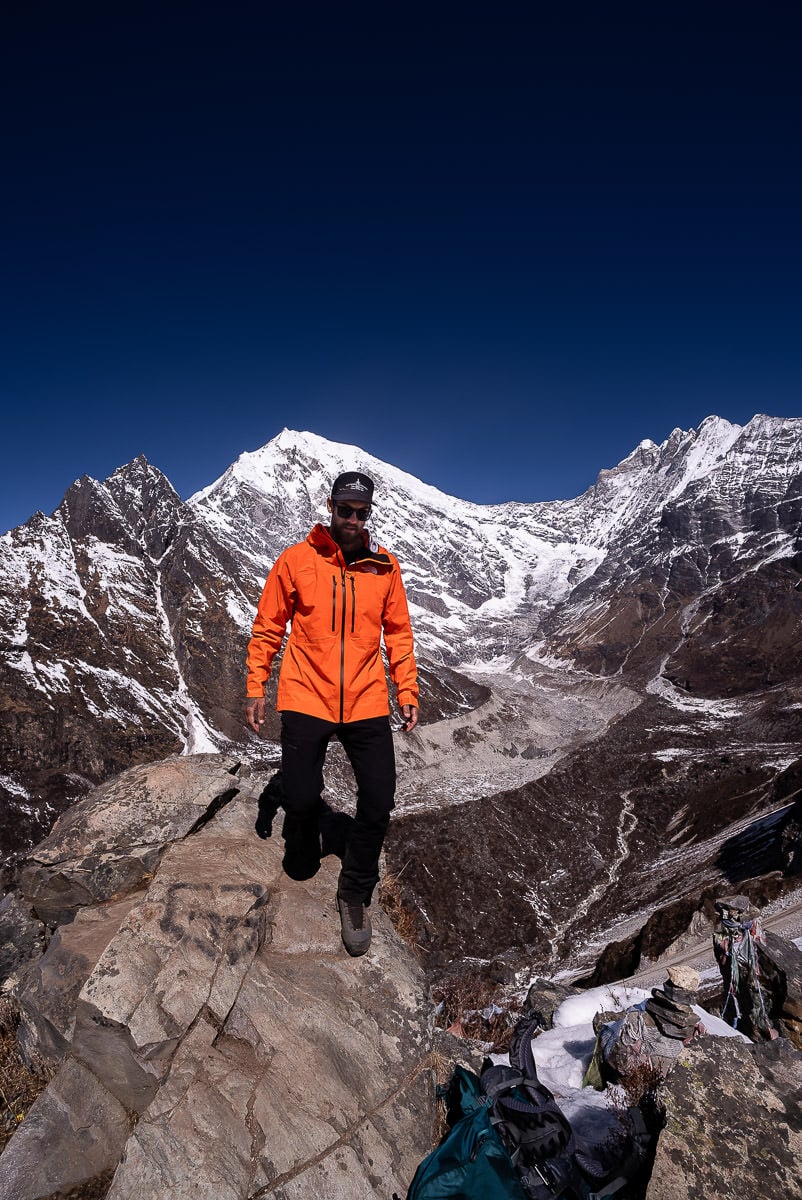
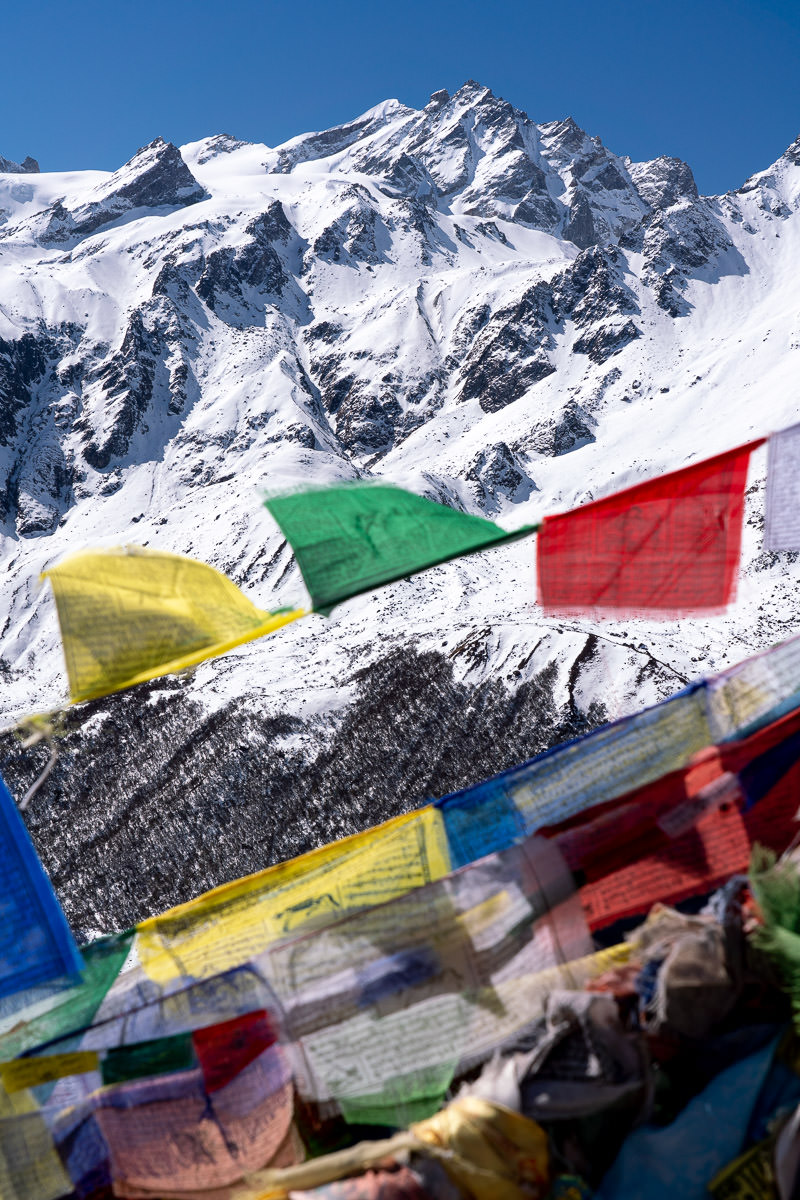
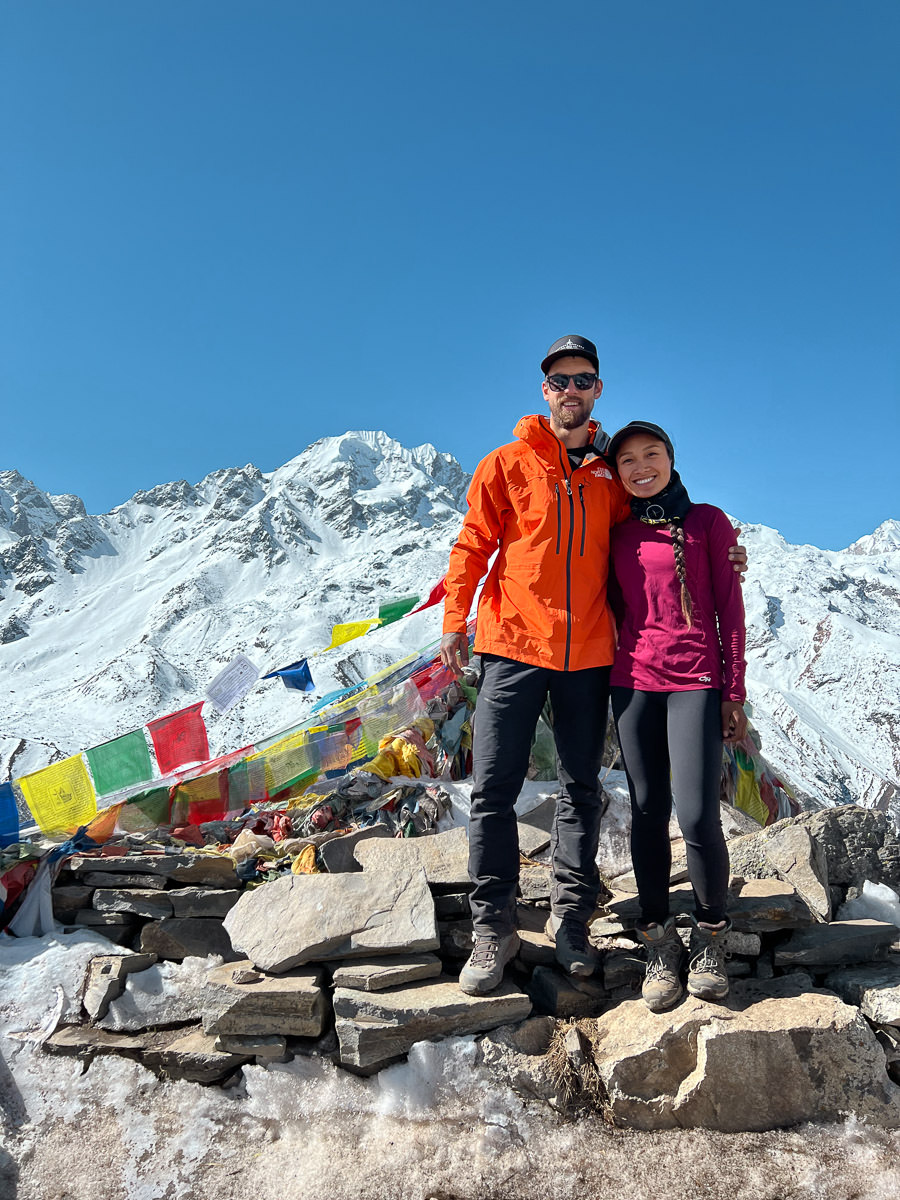
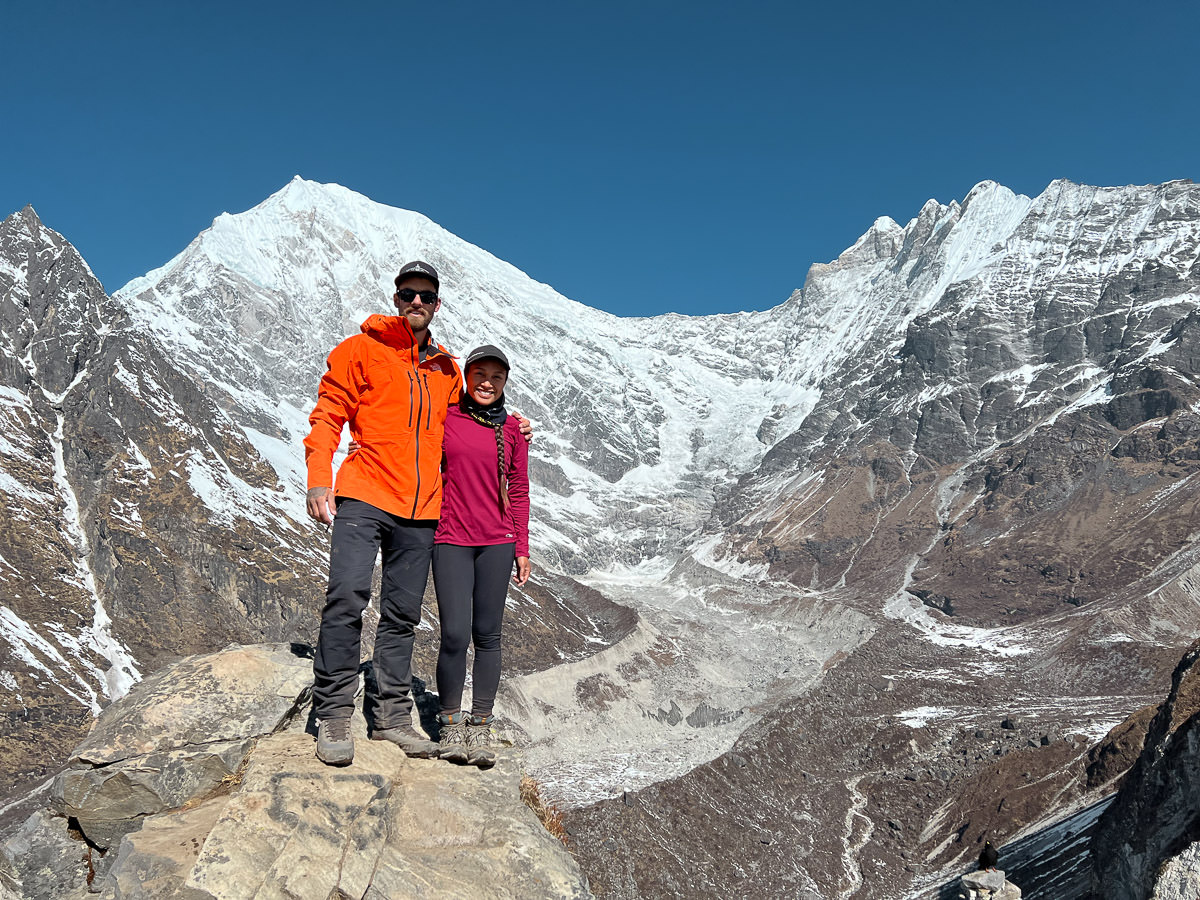
I suggest starting this hike just after sunrise as you won’t be too cold but you will also reach the summit before the afternoon clouds roll in. Take a packed lunch of Tibetan bread and an omelet from your tea house to eat at the summit and you are all set.
If you are interested in this expedition, I’ve written an entire guide about our Kyanjin Ri Hike.
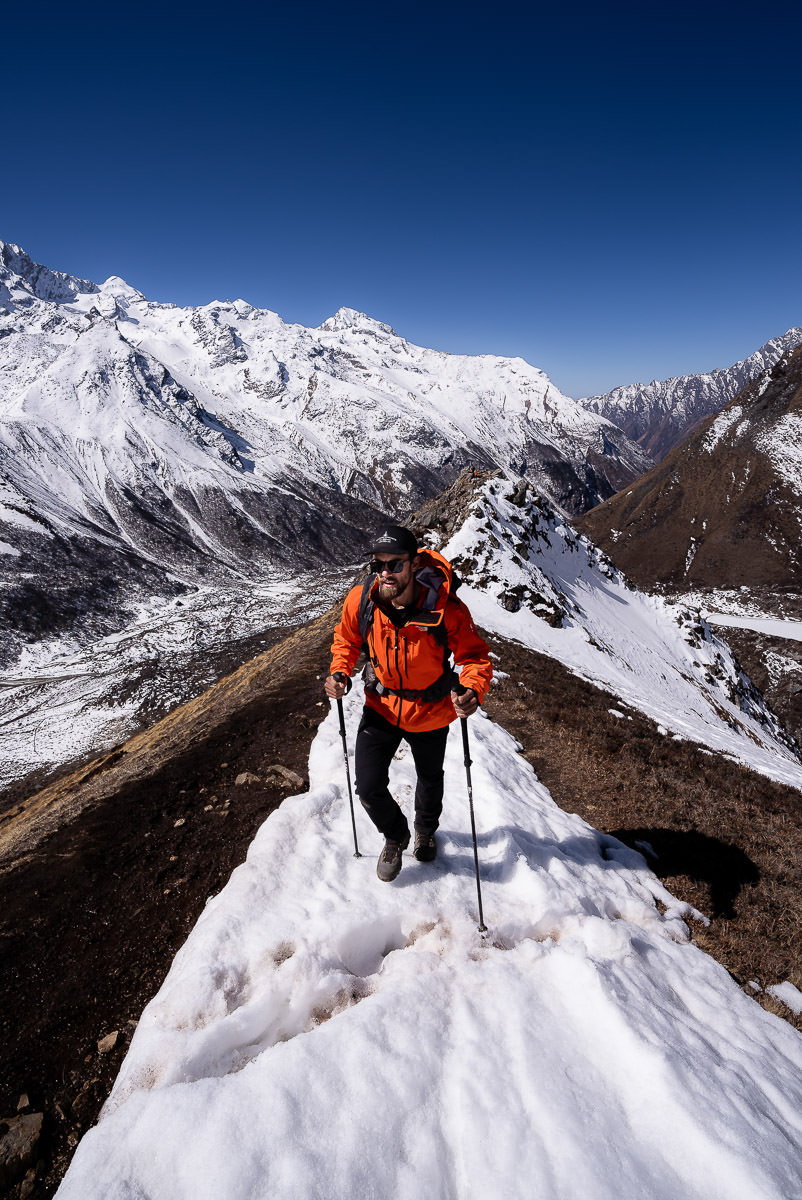
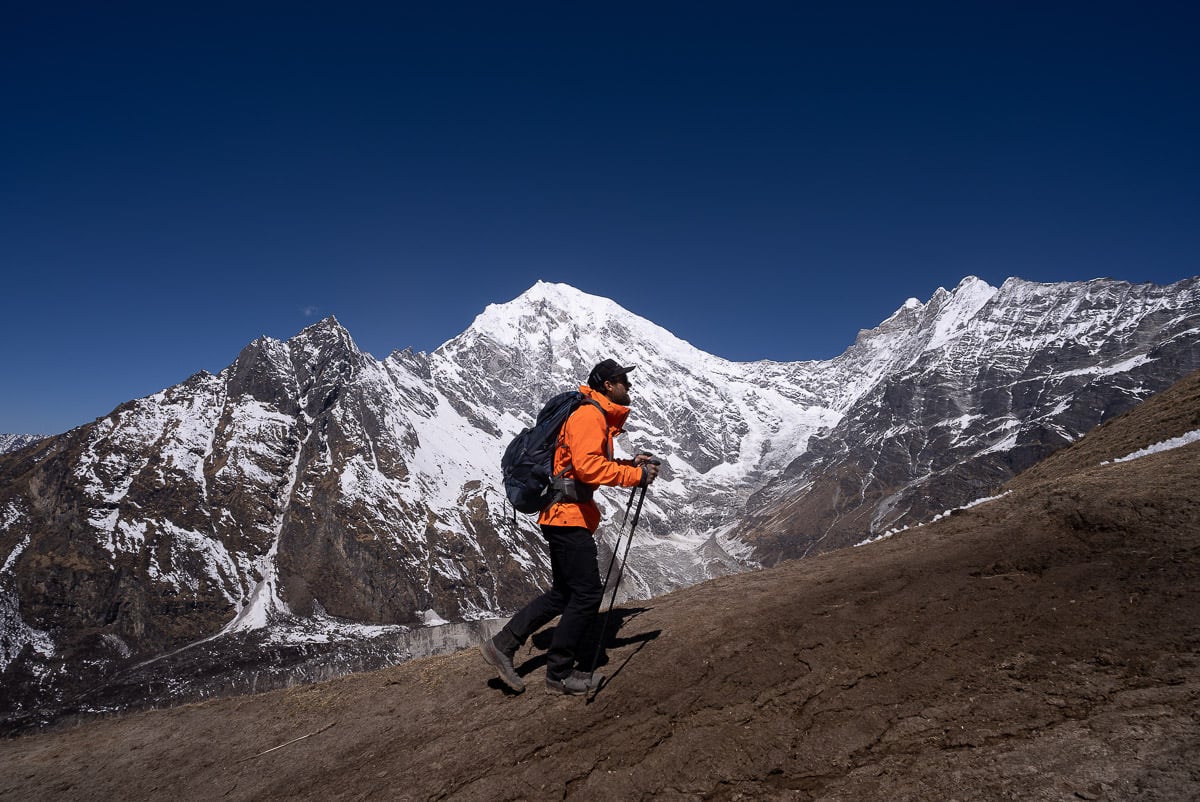
BEST INSURANCE FOR TRAVELERS
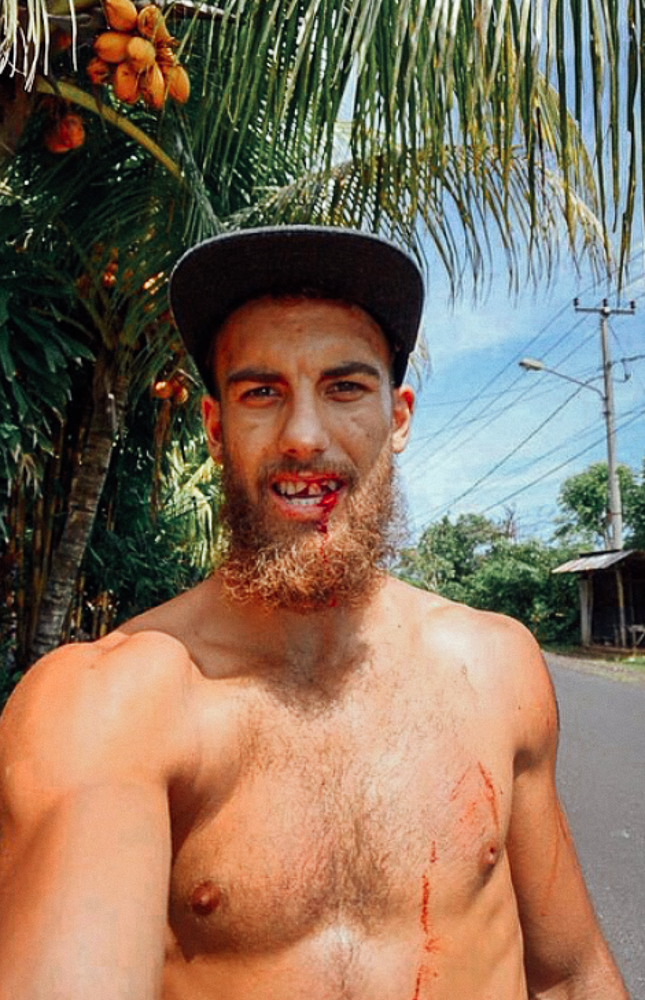
Don’t wait for an accident to happen… get insured! My travel insurance is HeyMondo which offers low-cost travel & medical insurance. That’s me on the left with three teeth knocked out after a motorbike crash in Bali!
You can click to read my Full Review of the Best Travel Insurance.
I’ve made several successful claims with HeyMondo and find their customer service very quick and helpful. Click the button below to get a 5% DISCOUNT
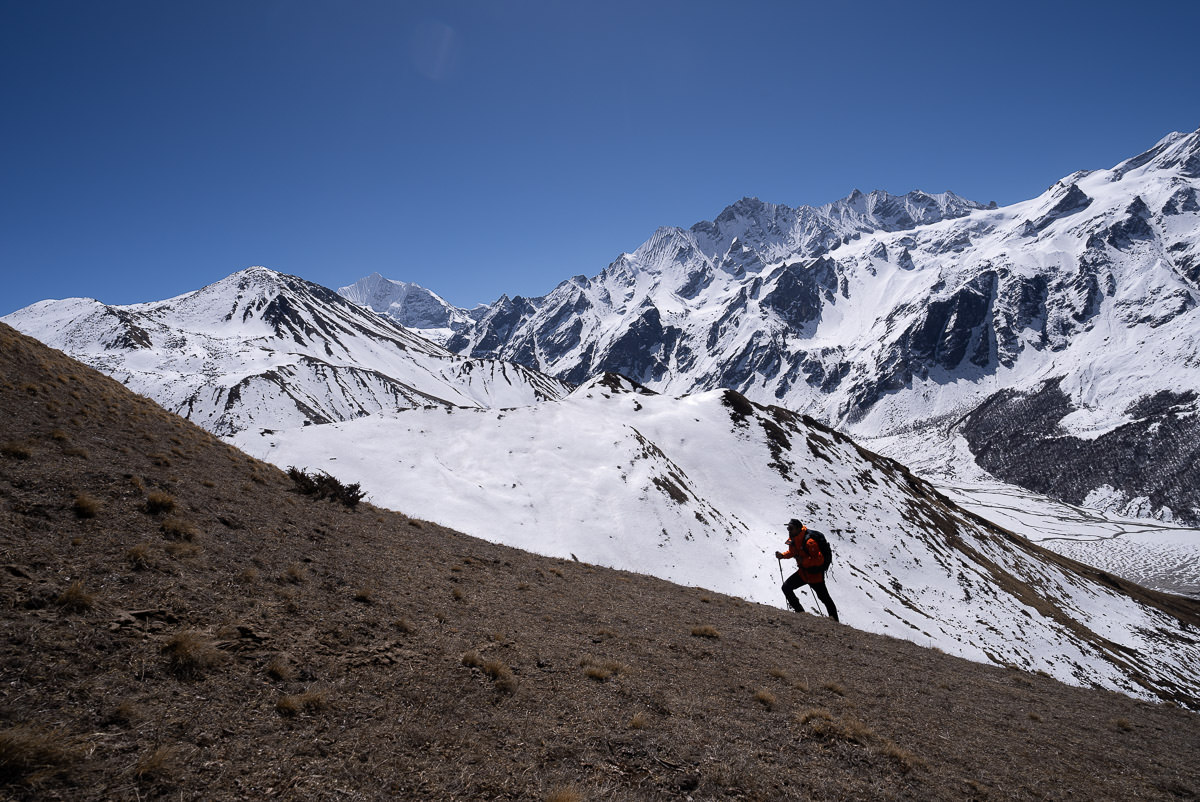
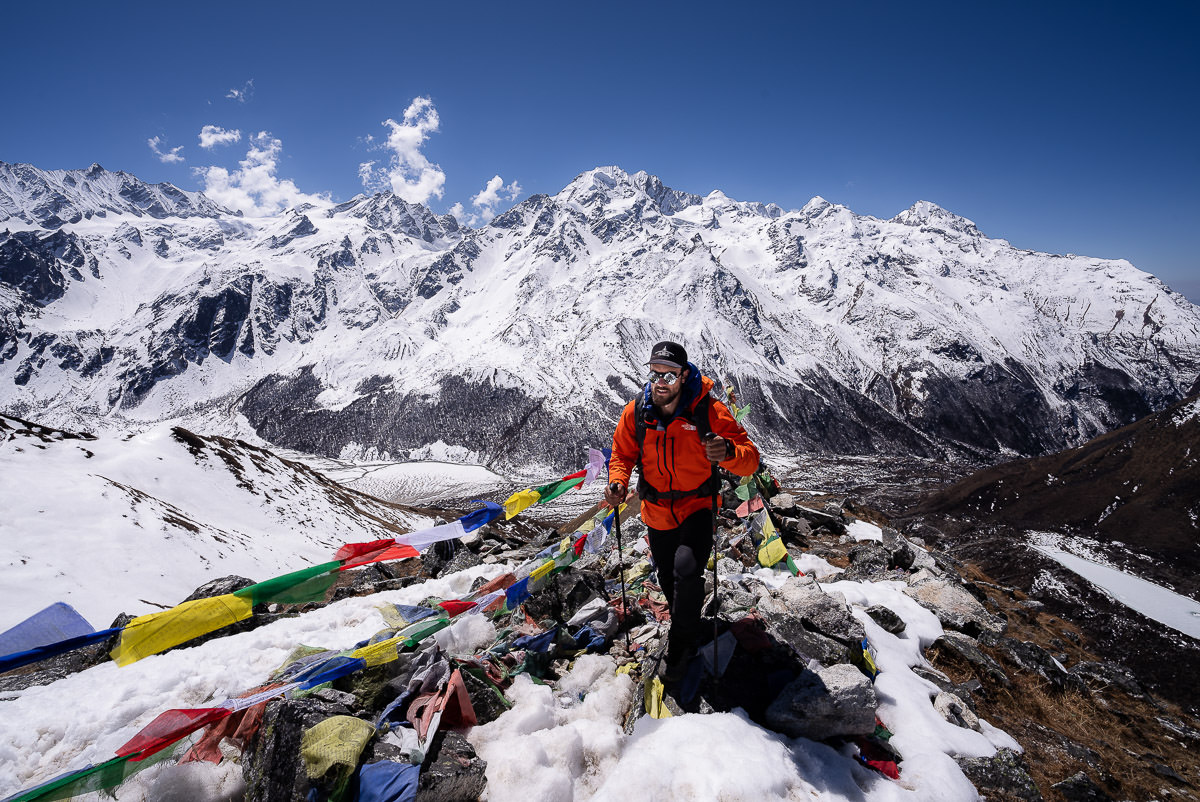

HIKING TO TSERKO RI FROM KYANJIN GOMPA
Tserko Ri (5,700m) is the finale for the Langtang Valley Trek. At 5,000m of elevation, this is a true test for trekkers against the elements and the altitude. It’s an optional day-hike, but one I highly suggest. Tserko Ri isn’t as hard as it sounds and is similar in many ways to its smaller brother, Kyanjin Ri.
The trek is about 8 kilometers in total with almost 1500m of incline throughout the day. It will definitely be a tough test and took us about seven hours to complete at a slow pace with lots of photos.
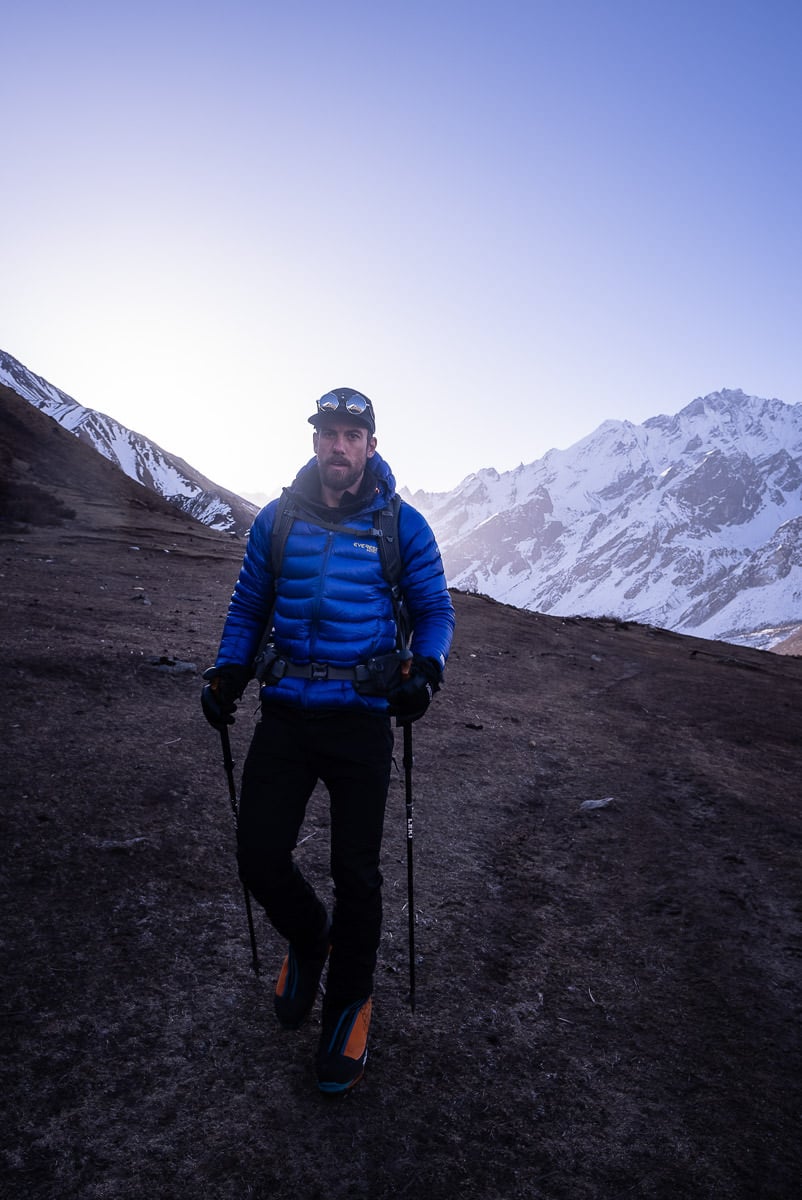



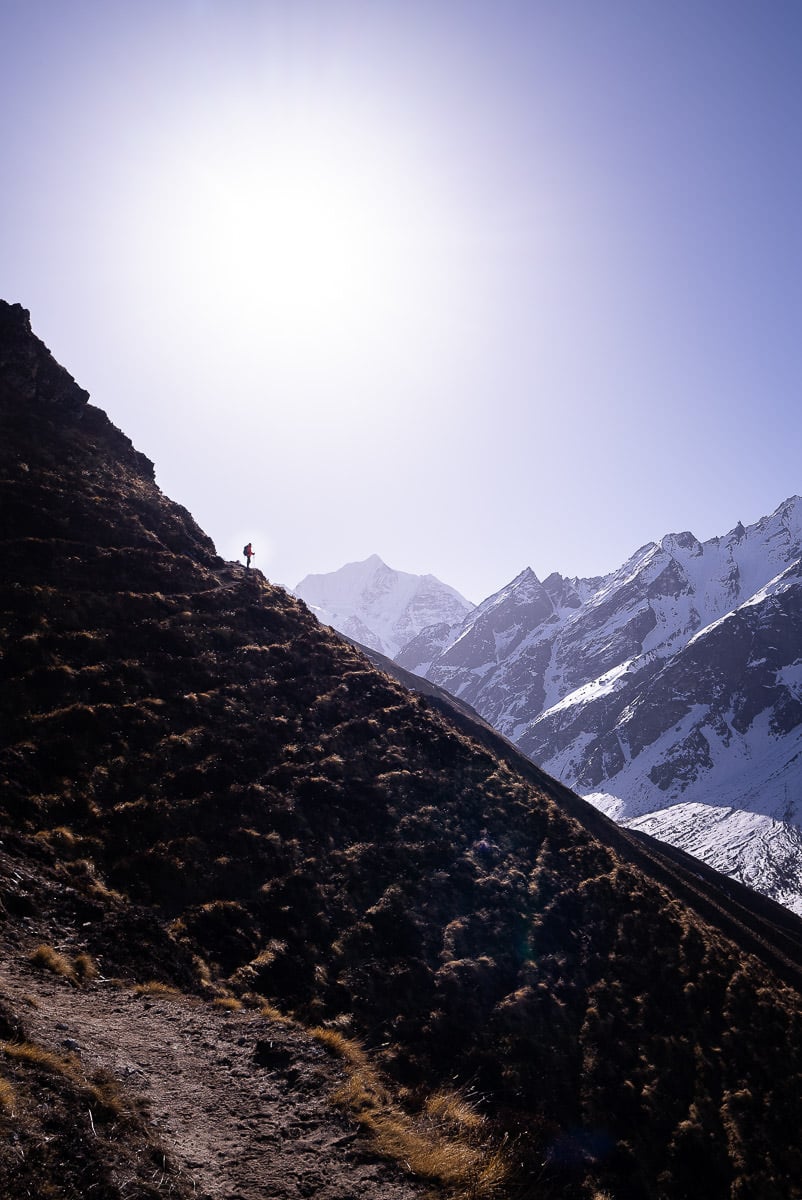


The trek takes you up a ridge all the way to the summit with very little danger to be found along the relatively wide and safe path. We visited just after winter and only encountered snow right at the last portion of the hike. Unfortunately, it was very soft and made it slow-going and difficult.
We managed to reach the summit and were the fourth and fifth people to touch the top for the season. Later in the season with less snow, this is a basic trekking peak and the only major consideration is the incline and the altitude.
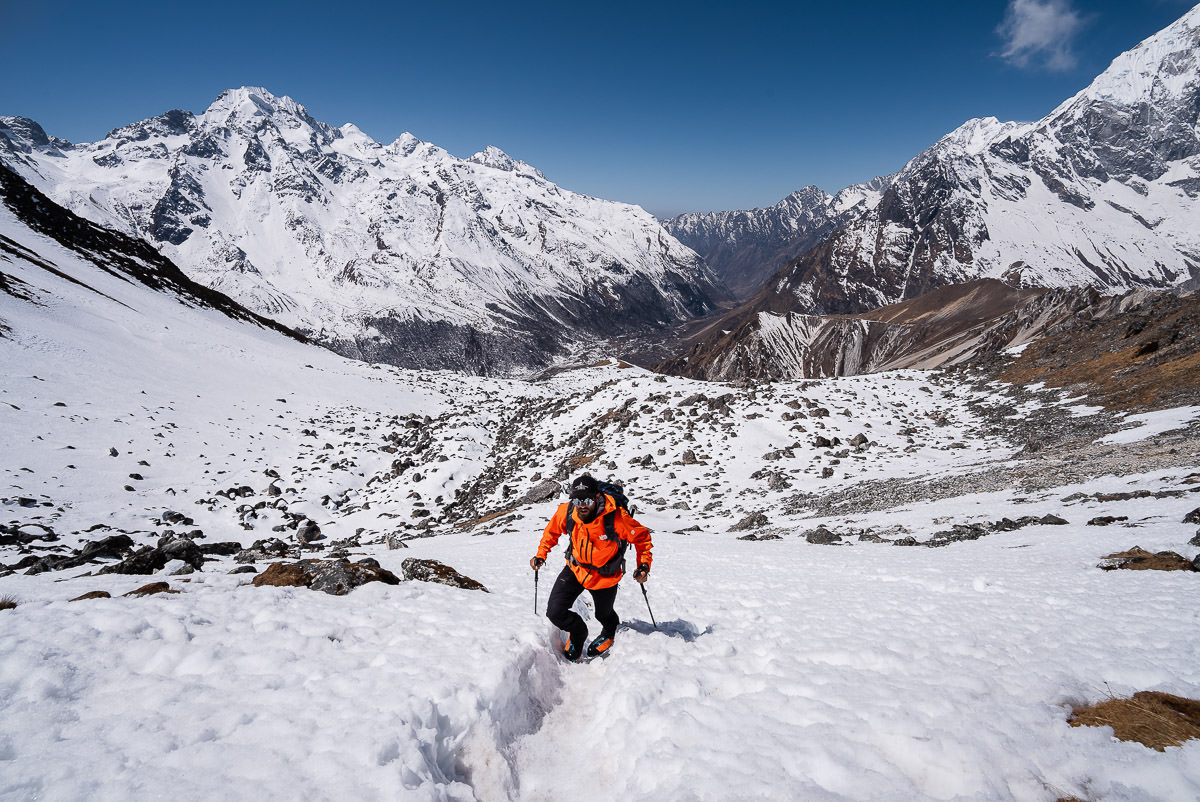
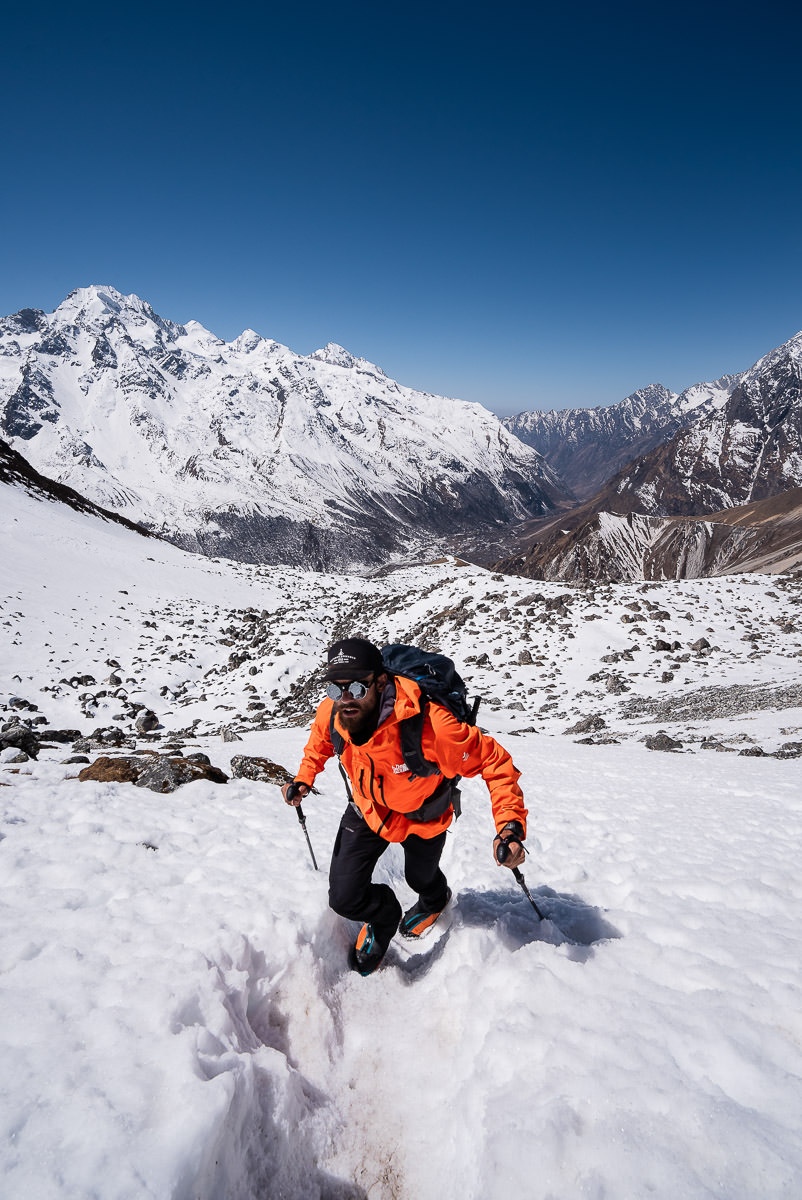
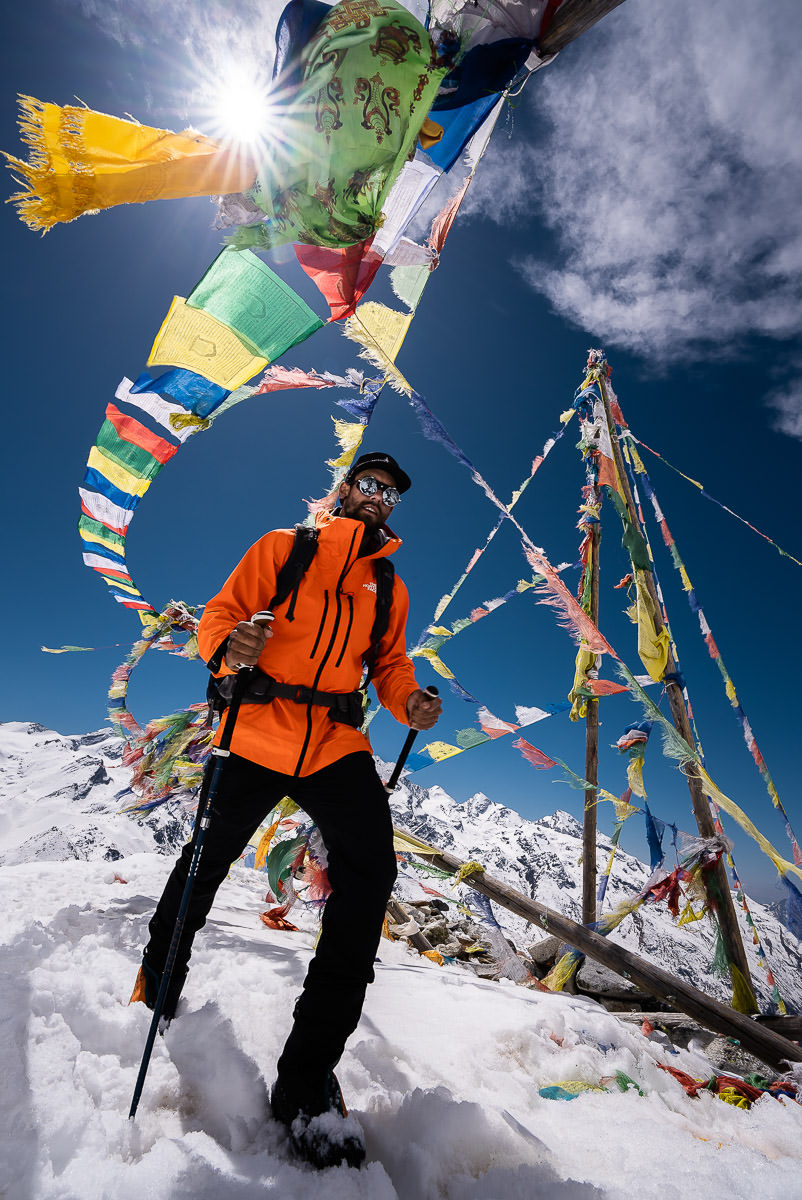

The summit of Tserko Ri is quite unique. A festival years ago at the summit involved carrying many large wooden poles to the top from which prayer flags were hung. There are so many poles and flags the summit has begun to look like a sailing ship. Nowhere in the Himalayas have I seen this many prayer flags at a summit, which made for a colorful, vibrant setting atop the peak.
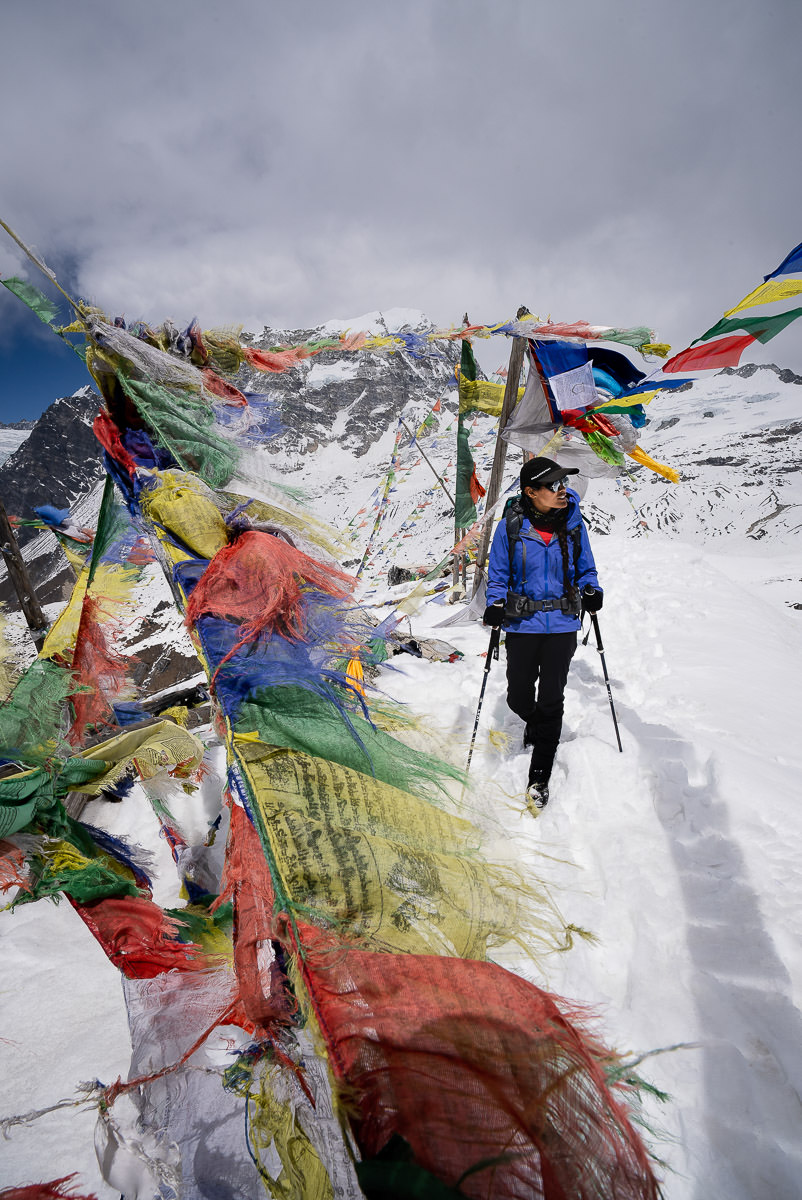


The views from Tserko Ri are simply phenomenal. With panoramic views, you can expect to see Yala Peak, Langtang Ri, Langtang Lirung, Naya Khang and many more.
As with Kyanjin Ri, it is best to be up at the summit before midday to avoid the afternoon clouds rolling in. I advise starting this hike no later than 7 am for the best possible conditions and views at the summit.
If you are interested in this expedition, I’ve written an entire guide about our Tserko Ri Hike.
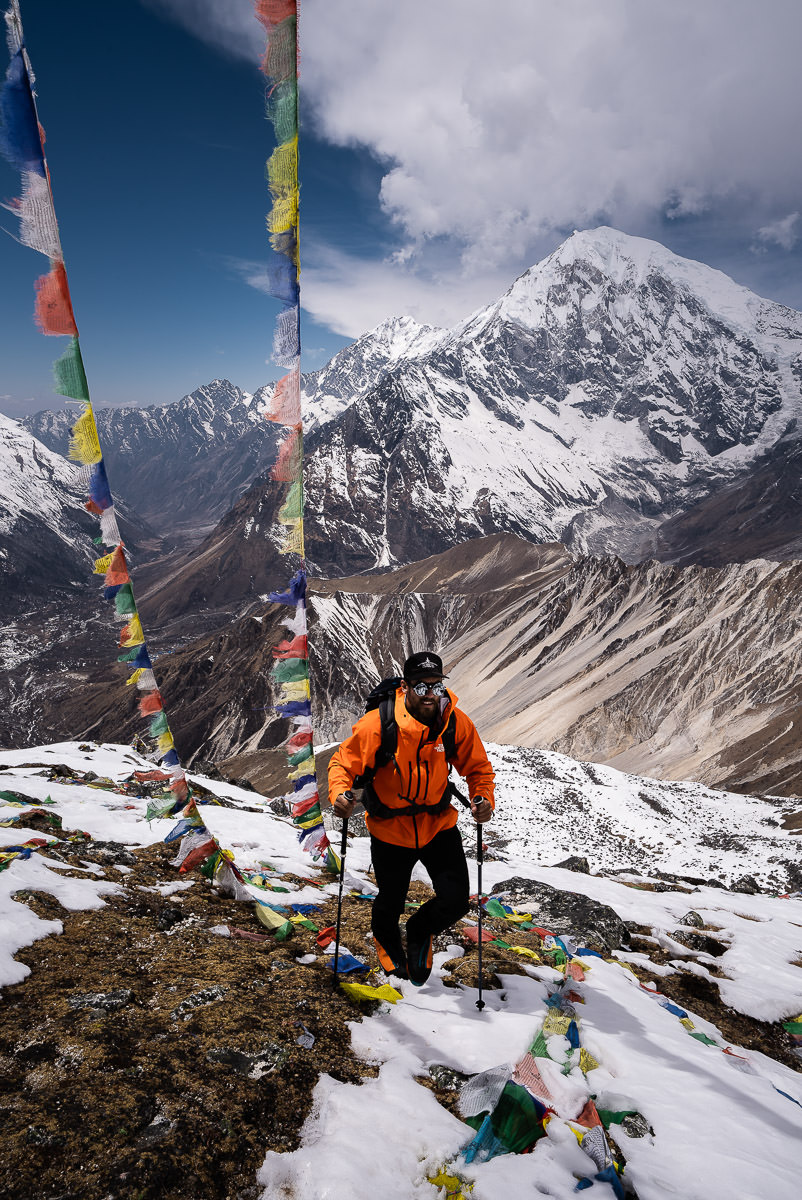
CLIMBING YALA PEAK
Yala Peak is a non-technical peak near Tserko Ri, which could be a great trekking peak for those on the hunt for a challenge.
We climbed Yala Peak with a guide over a two-day period. The climb included a trek to Yala Kharka (4750), which is the base camp. The summit push followed the next morning to Yala Peak (5,500m) through some heavy snow. With views into Tibet and specifically of Shishapangma, it was an incredible experience.
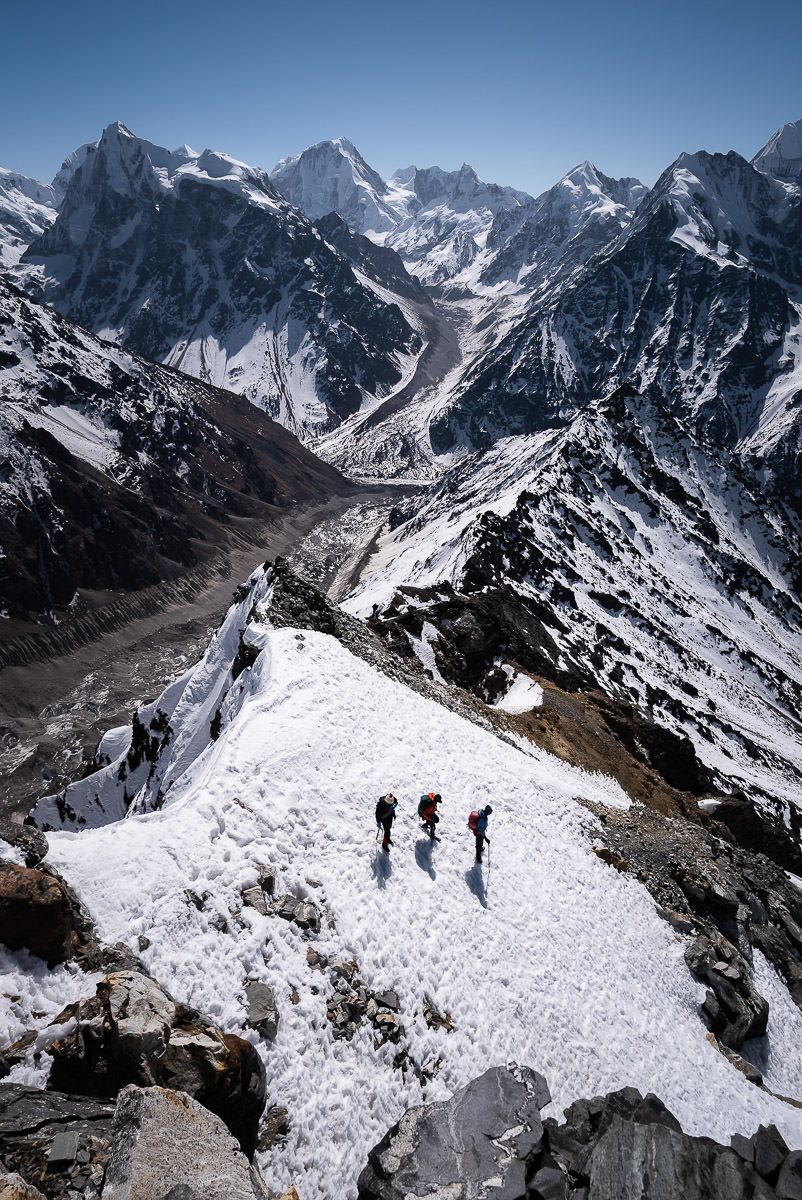
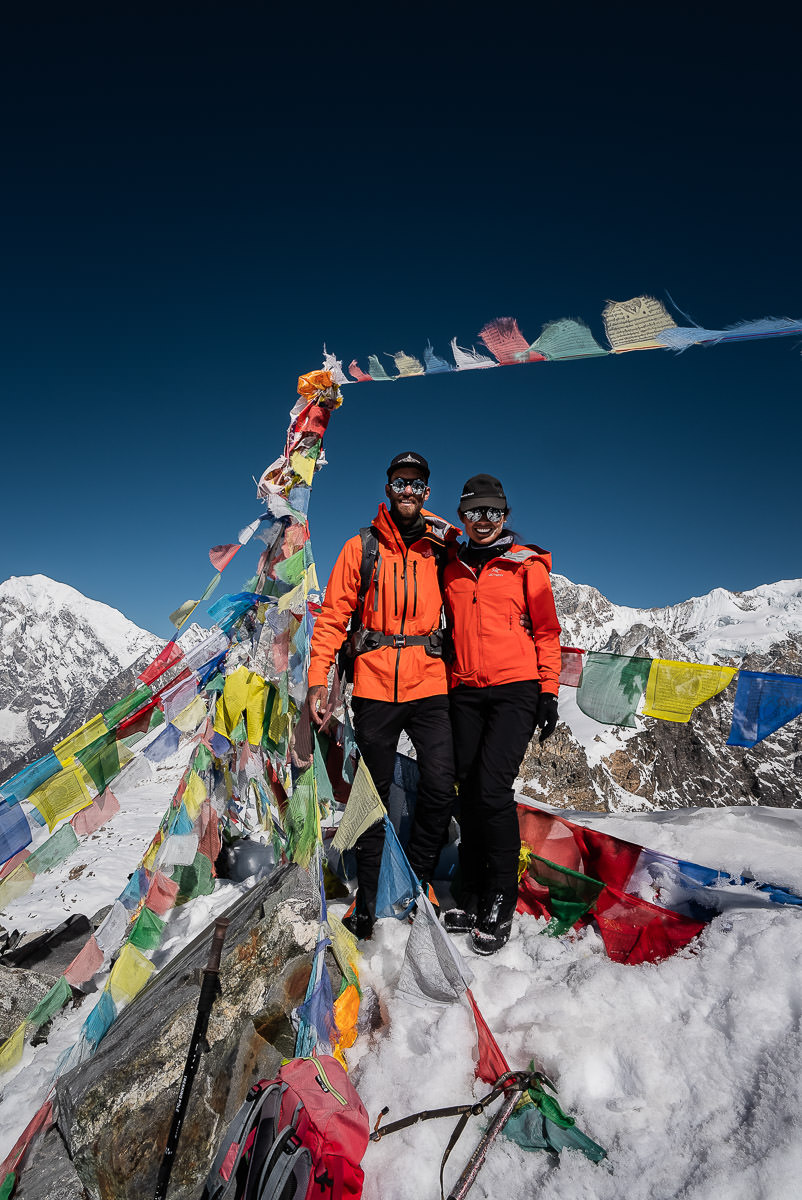
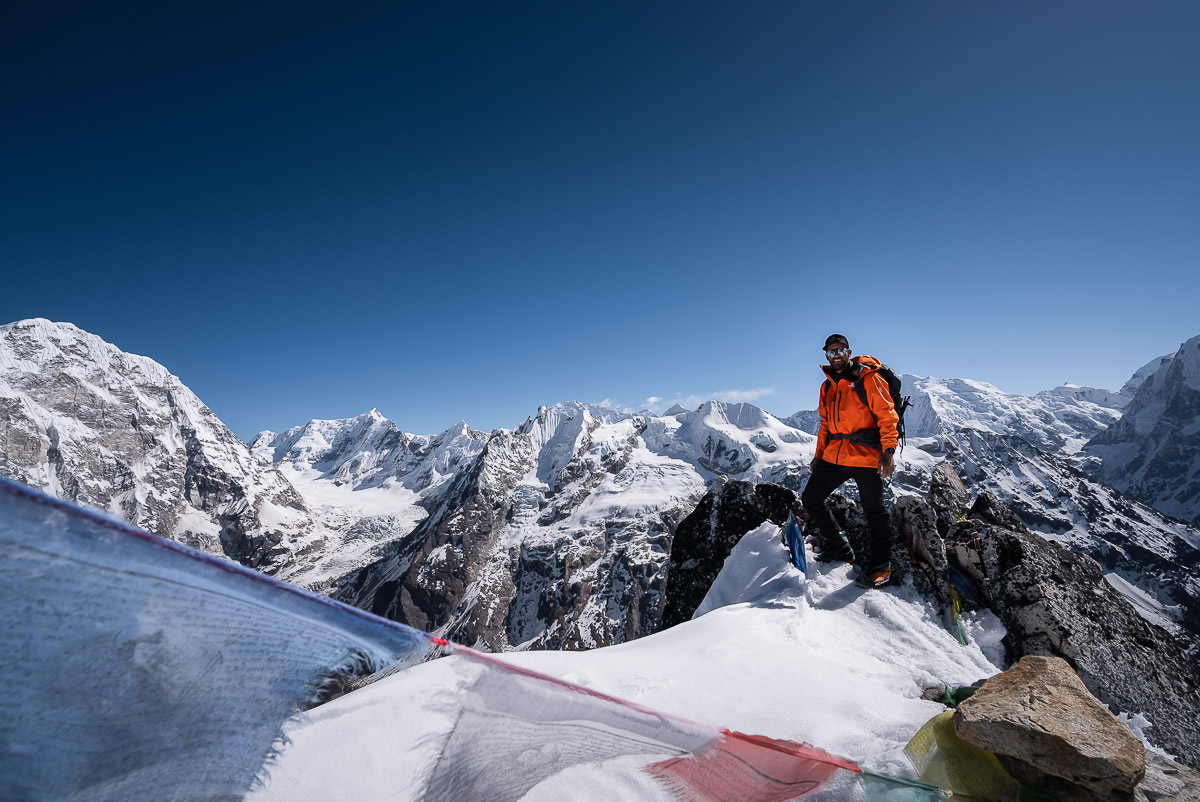
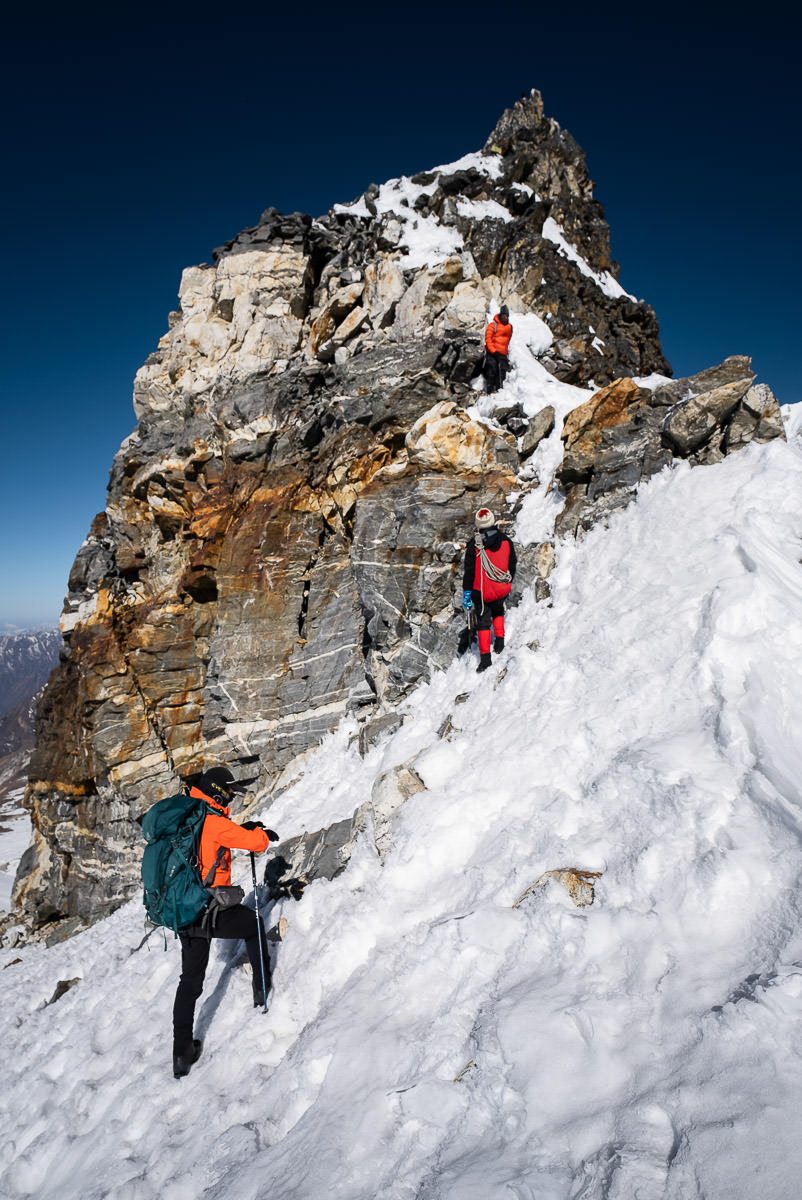
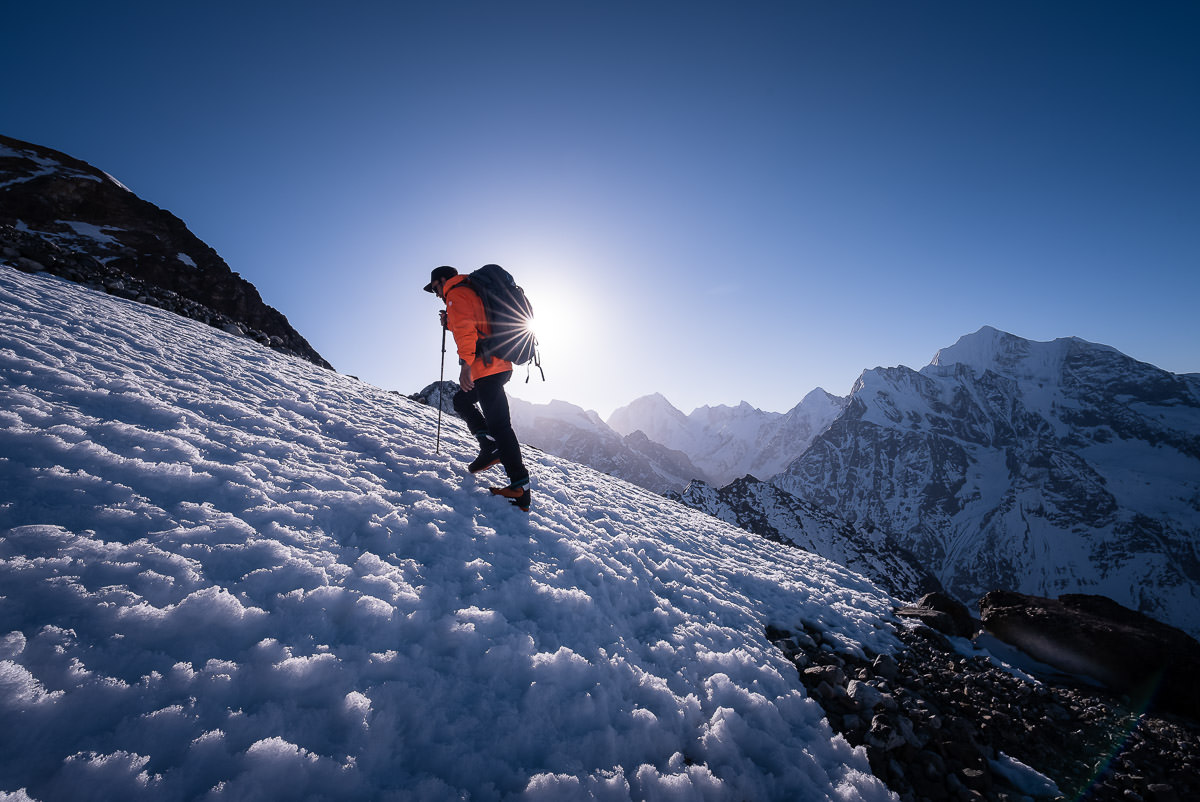
Yala Peak is not commonly part of the Langtang Valley Trek and involves prior preparation. We had to carry in our 6000m boots, extra warm gear, and climbing gear and arranged our climb in advance. While a guide can be arranged in Kyanjin Gompa, there is no gear rental shop so you may need to decide if Yala Peak is on your agenda before you begin the trek.
If you are interested in this expedition, I’ve written an entire guide about our Yala Peak Climb.
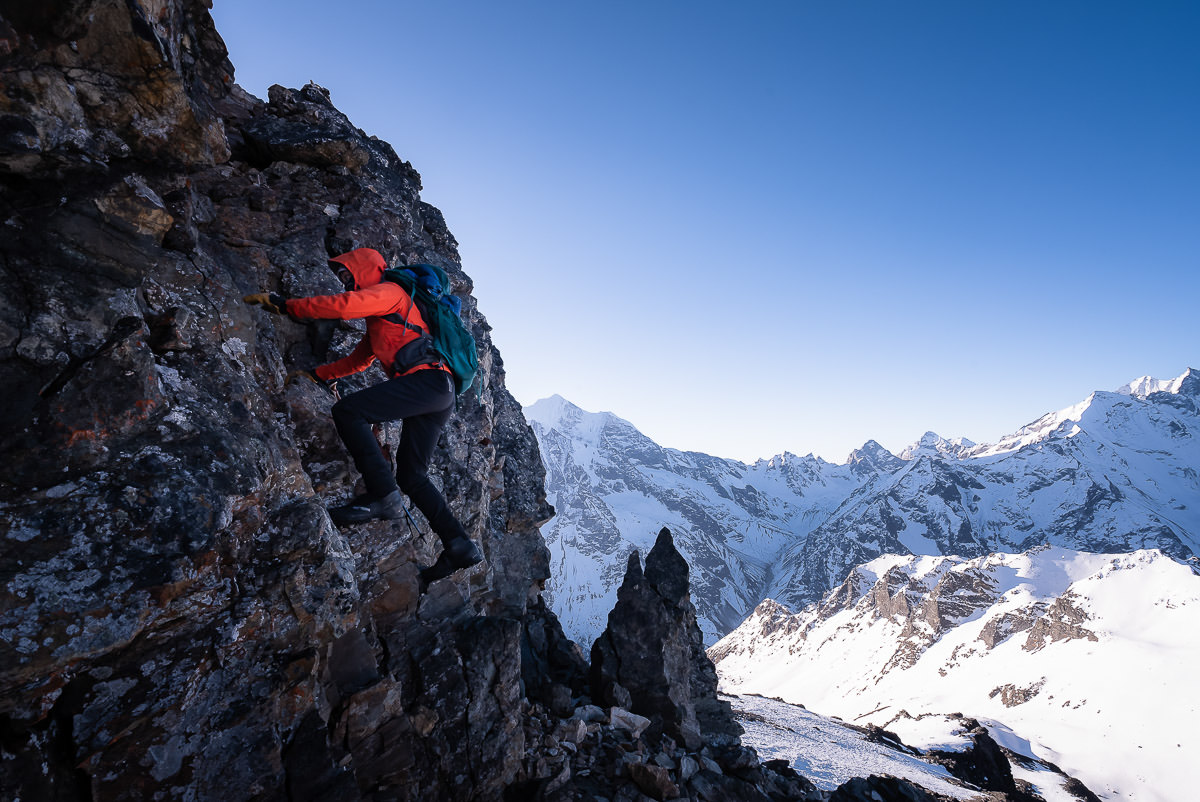

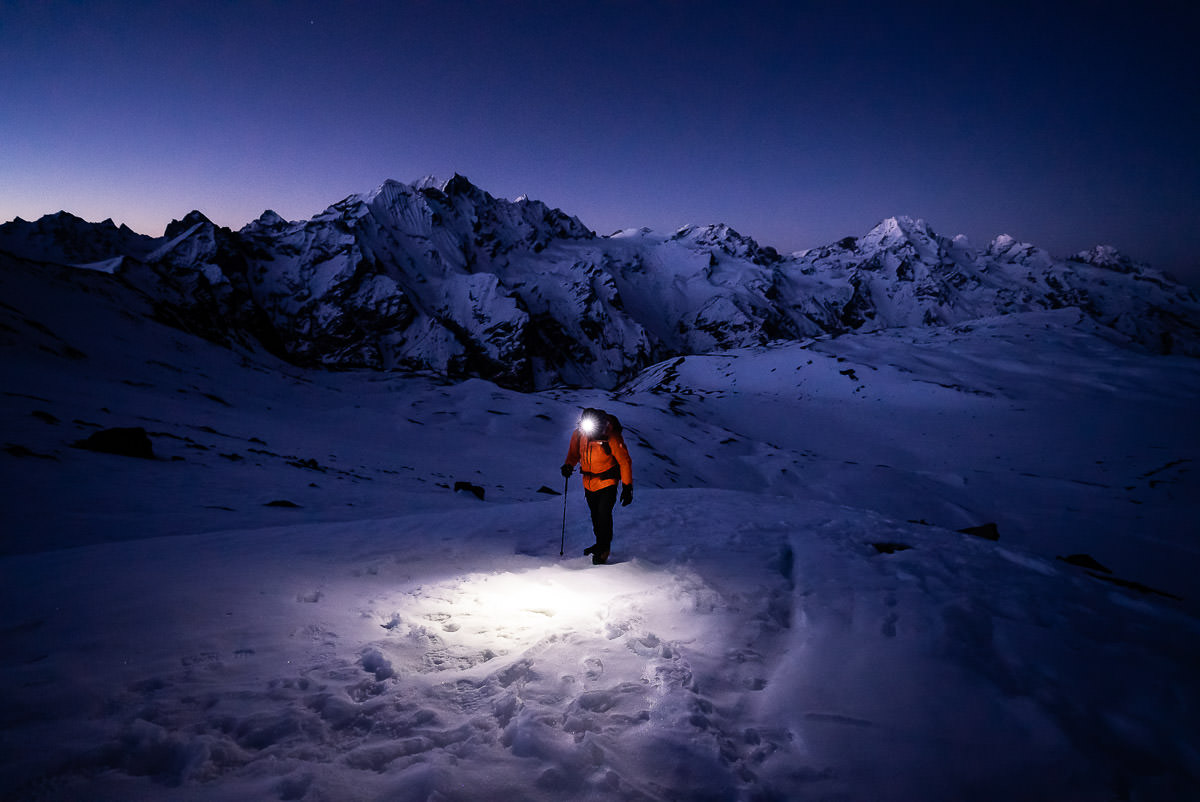
TREKKING FROM KYANJIN GOMPA TO SYABRUBESI
The trek back to Syabrubesi from Kyanjin Gompa takes most trekkers just two days. With only descent on the cards, it is much quicker than the trek upwards. On our first day of trekking, we made it all the way down to Lama Hotel with a 19km hike. On the second day, we had a 12km hike back to Syabrubesi.
It’s only 31km in total and there were some trekkers doing it all in one day. However, with more than 3000m of decline, I suggest taking at least two days for the descent as it can be quite tiring on the knees and ankles to endure so many steps and uneven surfaces.
After ten days out in the Langtang region, we wrapped up our trip with a celebratory beer at the Lhasa Hotel alongside a platter of Momo. It was one of our favorite treks and the expeditions from Kyanjin Gompa were wildly adventurous and incredible memories.
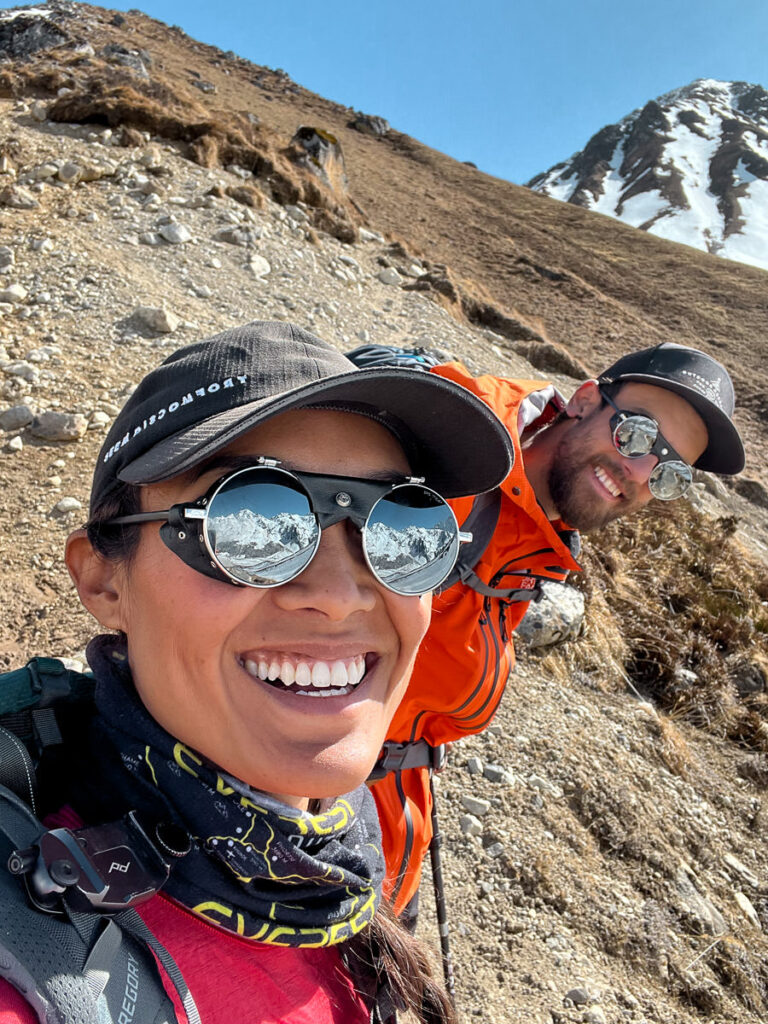
I hope you enjoyed this guide to the Langtang Valley Trek in Nepal and have a great experience yourself!
HAVE YOU READ MY OTHER NEPAL BLOGS?
I’ve been lucky enough to have many awesome adventures in Nepal, which you can check out below where I’ve listed some of my favorite blog poss from Nepal.
- The Most Iconic route: Everest Base Camp Trek
- The Most Scenic Route: Annapurna Circuit Trek
- My Favorite Trek in Nepal: Manaslu Circuit Trek
- An Easy Nepal Trek: Langtang Valley Trek
- A great beginner peak: Island Peak Climb (6,165m)
- My Favorite Climb in Nepal: Climbing Ama Dablam (6,812m)
- My first 8000er: Climbing Manaslu (8,163m)
- My toughest climb in Nepal: Climbing Makalu (8,463m)
- Where to stay: 16 Best Places to Stay in Kathmandu


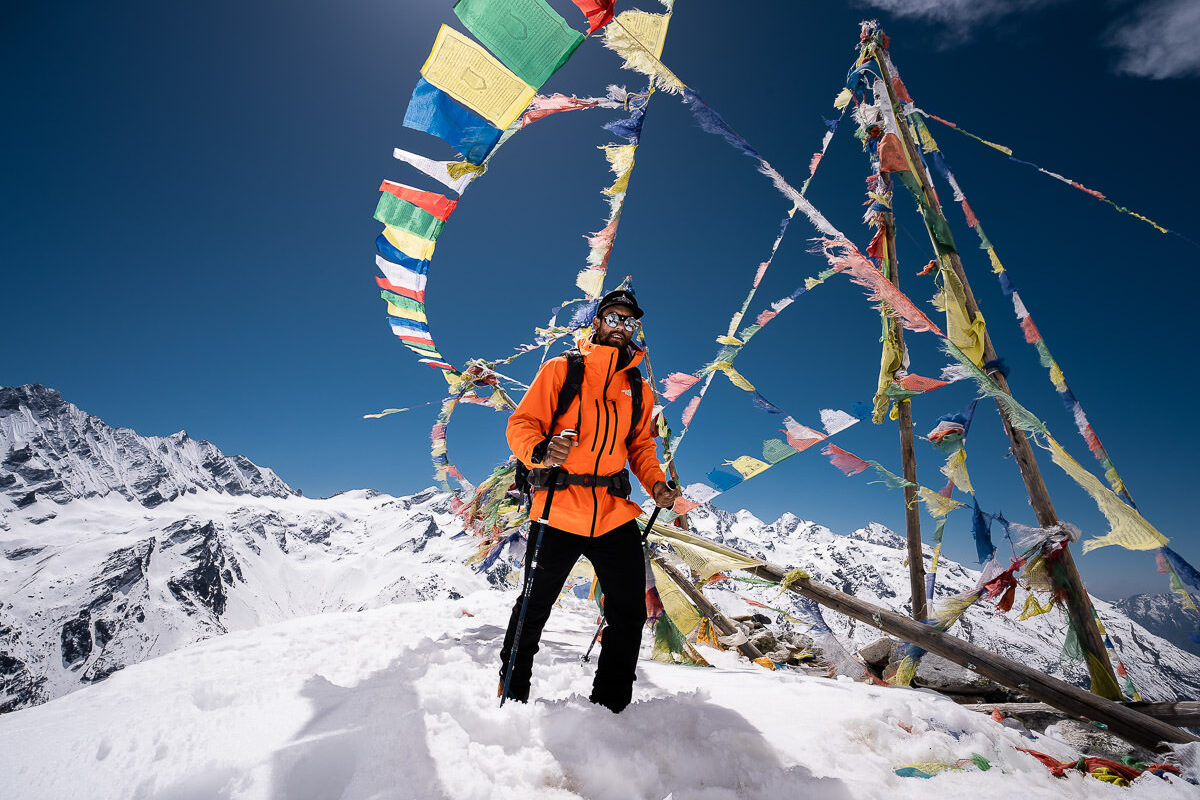
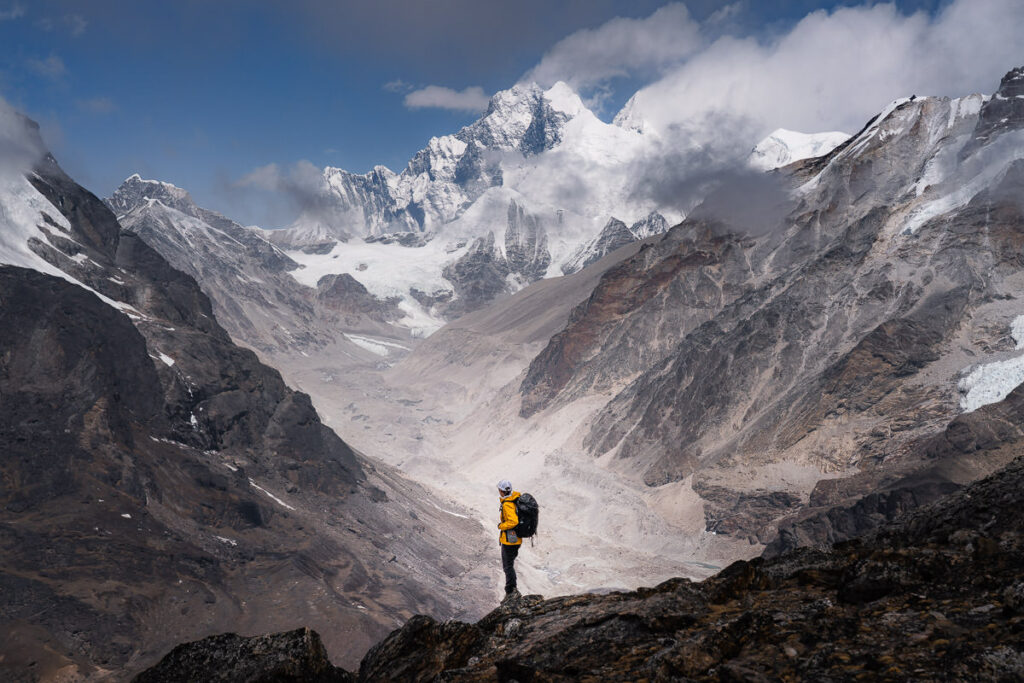
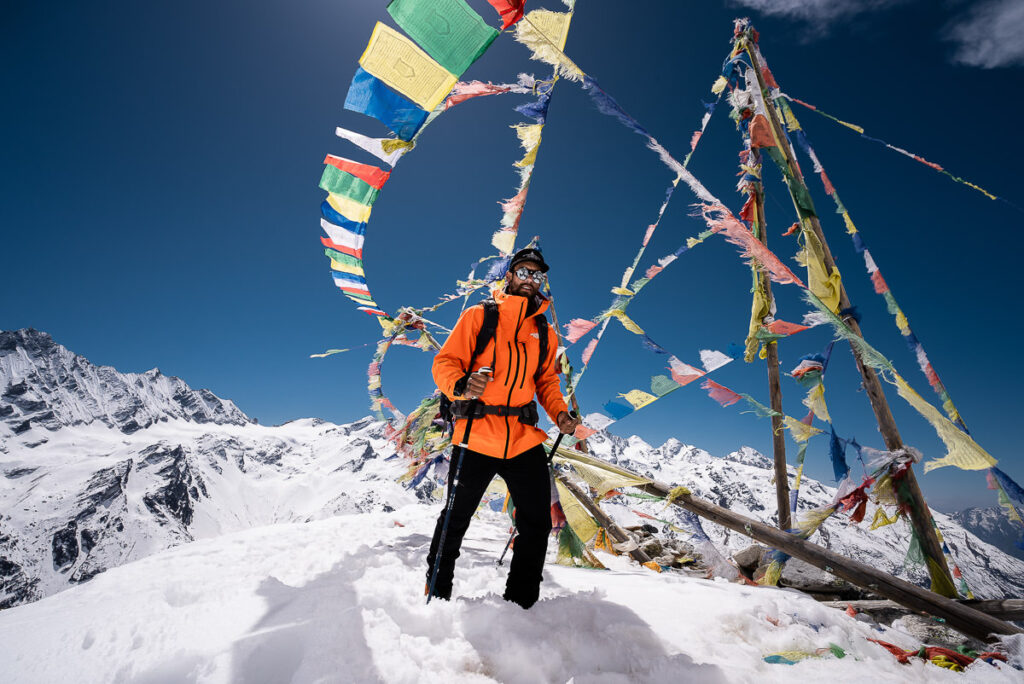
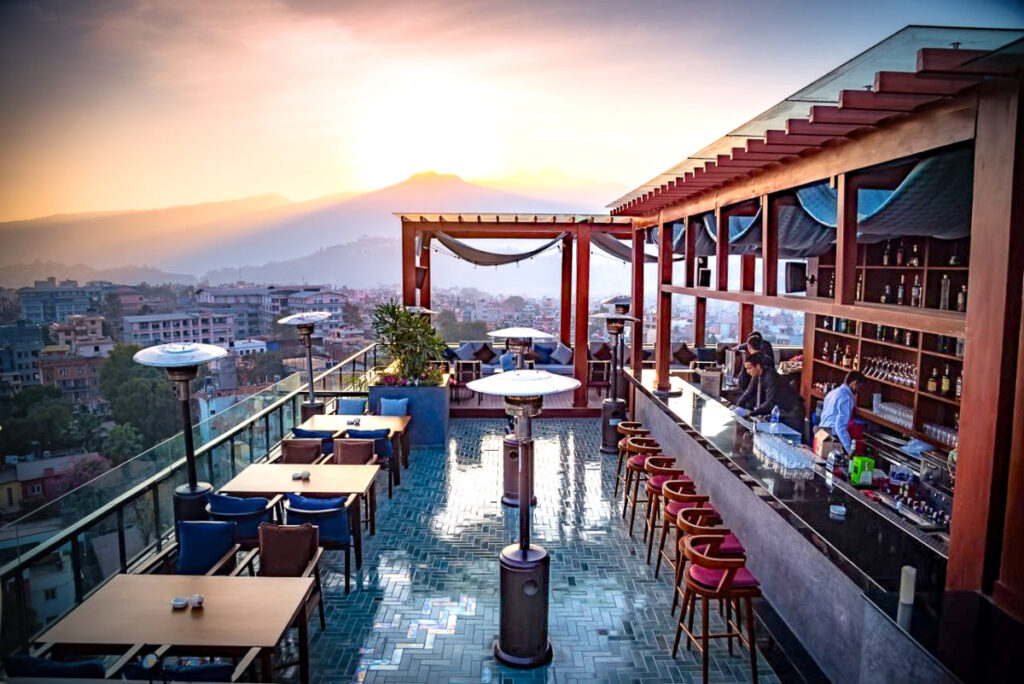
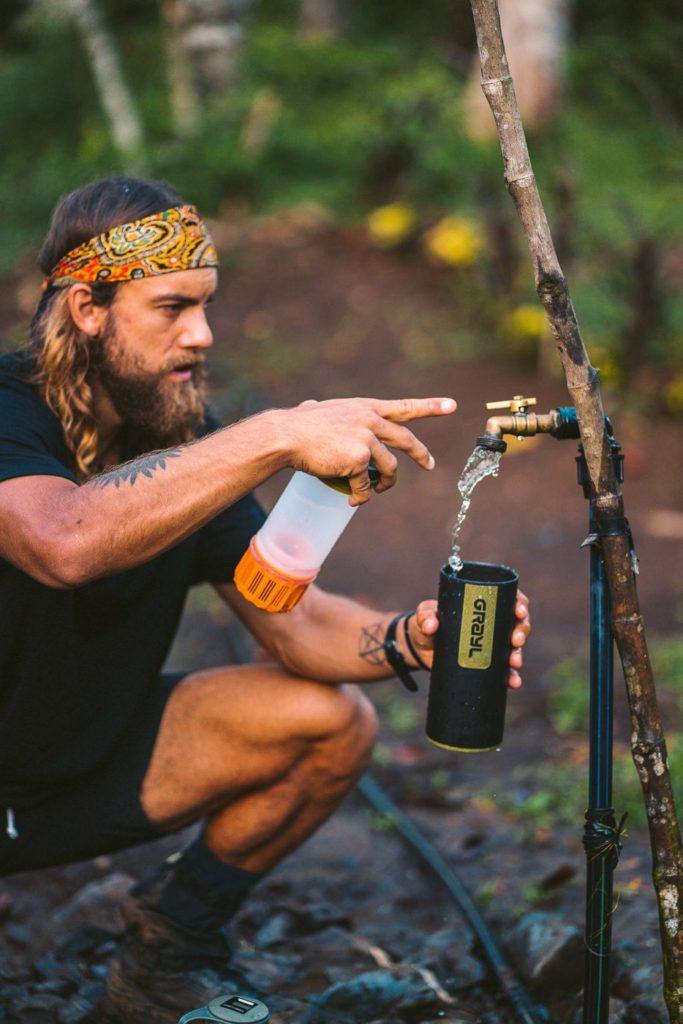
Paul
Saturday 13th of May 2023
This blog has me already planning this in my head. I love hiking and being from Australia, I didn't get much of this sort of thing there, nor, here in Thailand, but I feel like I'd be mad not to get on board with this whilst I'm living in this part of the world.
Hey guy below "Jay" I was living in Brisbane, and there are plenty of good training spots for a hike like this in QLD. Maybe not the snow, but if you want to spend a night on one of the local peaks in the middle of Winter, it'll get you ready, both physically and mentally. If you want a challenge and want to test yourself locally first, try hiking through Mount Kosciuszko area, you can go through the back way on a multiday hike and it's both physically and mentally challenging, and it feels so remote, it takes very little time in those sorts of mountains to feel very alone and vulnerable. But totally worth it!!
Thanks for the article! Brilliant.
Beverley
Tuesday 2nd of May 2023
Hello Jackson! What an incredible article with so many beautiful photos! I would have loved to have done the Langtang Valley trek with my mother when she was alive - she was the adventurous one, having climbed all of the Scottish Munros, summer and winter, including abseiling down the top of the InPin (I know, not a patch on Nepal!). Sadly, I lost her a couple of years ago, but even at 84 and dying of cancer, she still took us half way up Cairngorm! Maybe I'll manage it one day! Meantine, keep on trekking and stay safe!
Jay
Saturday 22nd of April 2023
Hi Jackson! Thank you for this very informative page. I'm hoping to hike this trek in November of this year. Absolute novice, barely done any hikes. I do keep fit with regular exercise though, and will train for this trek soon. I'm based in Queensland, Australia. I do have a fear of heights though, I was wondering what your thoughts were about the trek with this issue. Are there many suspension bridges and are they pretty high up? Would the trek otherwise be all right from that point of view? Thank you for your help. And I know it almost sounds ridiculous wanting to trek with a fear of heights but its something I've always wanted to do. Thank you for your time!